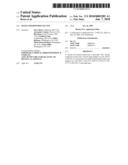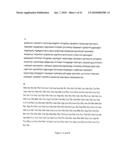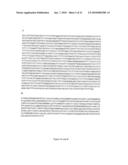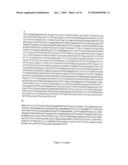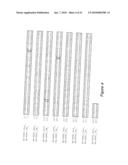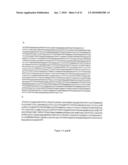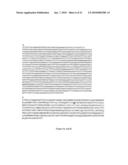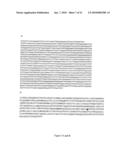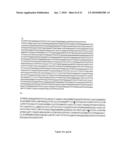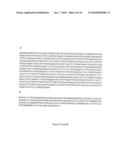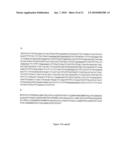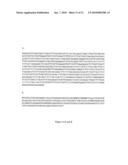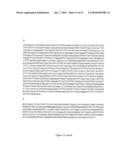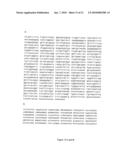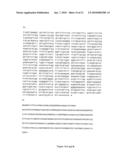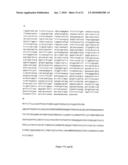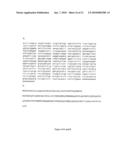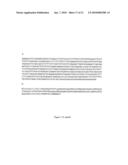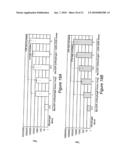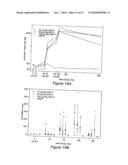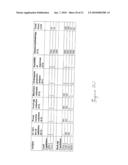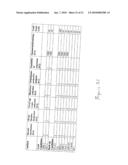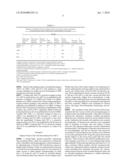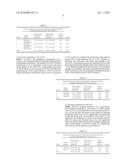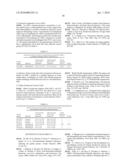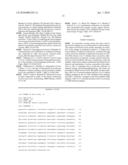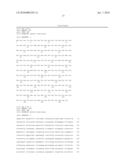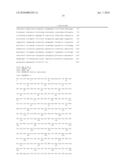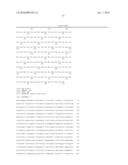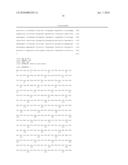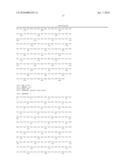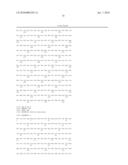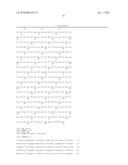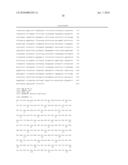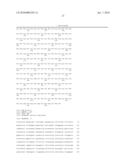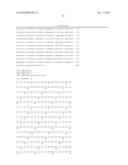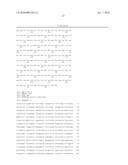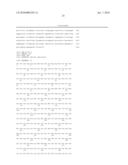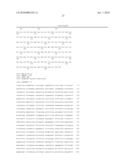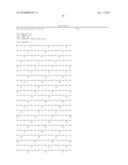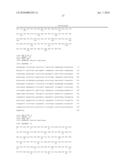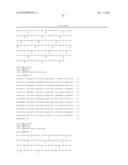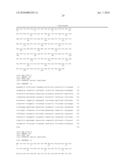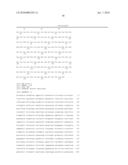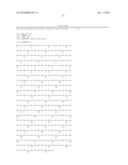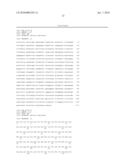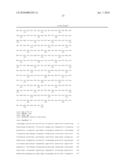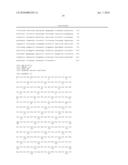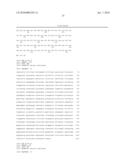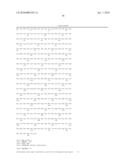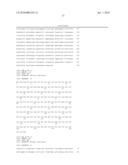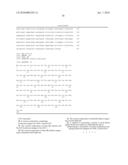Patent application title: Human Hookworm Vaccine
Inventors:
Peter Hotez (Bethesda, MD, US)
Alexander Loukas (Herston, AU)
Bin Zhan (North Potomac, MD, US)
Gaddam Goud (Gaithersburg, MD, US)
Jeffrey Bethony (Washington, DC, US)
Maria Elena Bottazzi (Washington, DC, US)
Aaron Miles (Washington, DC, US)
IPC8 Class: AA61K3900FI
USPC Class:
4242651
Class name: Drug, bio-affecting and body treating compositions antigen, epitope, or other immunospecific immunoeffector (e.g., immunospecific vaccine, immunospecific stimulator of cell-mediated immunity, immunospecific tolerogen, immunospecific immunosuppressor, etc.) parasitic organism or component thereof or substance produced by said parasitic organism (e.g., schistosoma, dirofilaria, trichinella, fasciola, ancylostoma, ascaris, etc.)
Publication date: 2010-01-07
Patent application number: 20100003285
Claims:
1-17. (canceled)
18. A vaccine composition, comprising,hookworm antigens Na-APR-1 and Na-GST.
19. The vaccine composition of claim 18, wherein said Na-GST hookworm antigen is Na-GST-1.
20. The vaccine composition of claim 18, further comprising an aluminum-based adjuvant.
21. The vaccine composition of claim 20, further comprising a second adjuvant.
22. A method of vaccinating a patient in need thereof against hookworm infection, comprising the step ofadministering to said patient a vaccine composition comprising hookworm antigens Na-APR-1 and Na-GST.
Description:
CROSS-REFERENCE TO RELATED APPLICATIONS
[0001]This application claims benefit of U.S. patent application Ser. No. 10/825,692, filed Apr. 16, 2004, and to U.S. provisional patent application 60/862,916, filed Oct. 25, 2006, the complete contents of both of which are hereby incorporated by reference.
BACKGROUND OF THE INVENTION
[0002]1. Field of the Invention
[0003]The invention generally relates to a vaccine for human hookworm. In particular, the invention provides a human hookworm vaccine comprising an L3 larval stage antigen (e.g. Na-ASP-2 or Na-SAA-2) and at least one adult stage human hookworm antigen (e.g. Na-APR-1, Na-CP-2, Na-CP-3, Na-CP-4, Na-CP-5, or Na-GST-1) and two or more adjuvants, one of which is an aluminum-based adjuvant such as Alhydrogel®.
[0004]2. Background of the Invention
[0005]Hookworms are gastrointestinal nematodes that infect approximately 600 million people in developing countries (Hotez et al, 2006a). Adult hookworms bury their heads beneath the mucosa of the human intestine and feed on blood. Moderate to heavy infections result in iron deficiency anaemia, the major pathologic sequella of hookworm disease, as well as protein malnutrition. The resulting hookworm disease and anemia has a serious deleterious impact on many aspects of the health of infected individuals, including childhood growth retardation and cognitive development, and impaired fetal development during pregnancy (Hotez et al, 2004). The global disease burden resulting from chronic hookworm infection in childhood and pregnancy is enormous, possibly as high as 22 million disability-adjusted life years annually (Chan, 1997), making hookworm the second most important parasitic infection of humans after malaria (Hotez et al, 2005). In addition, the chronic immune suppression induced by hookworms and other helminths also has enormous impact on the ability of people to respond in a competent fashion to other infections (including malaria and HIV/A/DS and vaccines (Elliott et al, 2005; Su et al. 2005; Cooper et al., 2001; Cooper et al., 1999; Hotez et al, 2006b).
[0006]Unlike many other human helminthiases, clear-cut immunity against hookworms does not develop in the majority of infected individuals (Loukas et al., 2005). Indeed, the oldest people living in an endemic community sometimes have the heaviest worm burdens (Bethony et al., 2002). While anthelminthic drugs of the benzimidazole class are highly effective at eliminating existing hookworm infections, they do not protect against rapid re-infection (Hotez et al, 2006a). In areas of high transmission, hookworm re-infection will occur within 4-12 months (Albonico et al, 1995), leading to concerns about the long-term sustainability of such practices (Kremer 2004). In addition, newer data indicates that the efficacy of benzimidazole drugs decreases with frequent use (Albonico et al, 2003), leading to concerns about the possibility that anthelminthic drug resistance has developed (Albonico et al, 2004; Bethony et al, 2006). These observations have led to calls by the World Health Organization and other international agencies to develop new tools for the control of hookworm, including a hookworm vaccine (WHO, 2005). Therefore, an anthelminthic vaccine that induces immunological protection to minimize pathology and interrupt hookworm transmission is a highly desirable goal.
[0007]While regional economic growth (and with it, improvements in sanitation and clean water) in some parts of North America, Japan, South Korea, and China have translated into substantial reductions in endemic hookworm (Hotez et al, 2006a), estimated prevalence rates for the world's poorest and least developed regions remain high. For example, infection rates in sub-Saharan Africa (SSA) are equivalent to those first estimated more than 60 years ago (DeSilver et al., 2003), where an estimated 198 million cases occur (DeSilva et al, 2003). High hookworm infestation rates are principally in poverty-stricken rural areas where access to medical care is severely limited. Widespread use of a hookworm vaccine would lead to significant improvement in global health and in economic development (Hotez et al, 2006a; Hotez and Ferris, 2006). Therefore, an ideal vaccine hookworm vaccine would also be relatively easy and inexpensive to produce, and would be effective without the need for constant boosting.
[0008]The prior art has thus far failed to provide such a vaccine against human hookworm.
SUMMARY OF THE INVENTION
[0009]It is an object of this invention to provide a bivalent human hookworm vaccine. The vaccine is effective at inducing an immune response in individuals to whom it is administered, and administration results in a reduction in symptoms of hookworm disease.
[0010]The vaccine comprises: one or more L3 larval stage antigen (e.g. Na-ASP-2 and/or Na-SAA-2) and at least one adult stage human hookworm antigen (e.g. Na-APR-1, Na-CP-2, Na-CP-3, Na-CP-4, Na-CP-5, or Na-GST-1) and one or more adjuvants. In some embodiments, the vaccine composition includes two or more adjuvants, one of which is an aluminum-based adjuvant such as Alhydrogel®.
[0011]The present invention provides a hookworm vaccine comprising a hookworm larval stage antigen, a hookworm adult stage antigen, and one or more adjuvants. In one embodiment of the invention, the vaccine includes at least one larval-stage hookworm antigen, at least one adult-stage hookworm antigen, an aluminum-based adjuvant, and a second adjuvant. In one embodiment of the invention, the larval-stage hookworm antigen is Na-ASP-2 or Na-SAA-2, or both. Further, the larval-stage hookworm antigen may be antigenic fragments of Na-ASP-2 or Na-SAA-2, or both. In one embodiment of the invention, the adult-stage hookworm antigen is Na-APR-1, Na-GST, Na-CP-2, Na-CP-3, Na-CP-4, Na-CP-5, or antigenic fragments thereof, or a combination of several of these antigens. In one embodiment of the invention, the Na-APR-1 that is utilized is Pichia optimized Na-APR-1, or an antigenic fragment thereof. In some embodiments, the aluminum-based adjuvant is Alhydrogel® and the second adjuvant is CpG or Synthetic lipid A. In some embodiments of the invention, the aluminum-based adjuvant and the second adjuvant are combined together.
[0012]The invention also includes a method for vaccinating a patient in need thereof against hookworm infections. The method comprises the step of administering to the patient a hookworm vaccine comprising a hookworm larval stage antigen, a hookworm adult stage antigen, and one or more adjuvants. In one embodiment of the invention, the vaccine includes at least one larval-stage hookworm antigen, at least one adult-stage hookworm antigen, an aluminum-based adjuvant, and a second adjuvant. In one embodiment of the invention, the larval-stage hookworm antigen is Na-ASP-2 or Na-SAA-2, or both. Further, the larval-stage hookworm antigen may be antigenic fragments of Na-ASP-2 or Na-SAA-2, or both. In one embodiment of the invention, the adult-stage hookworm antigen is Na-APR-1, Na-GST, Na-CP-2, Na-CP-3, Na-CP-4, Na-CP-5, or antigenic fragments thereof, or a combination of several of these antigens. In one embodiment of the invention, the Na-APR-1 that is utilized is Pichia optimized Na-APR-1, or an antigenic fragment thereof. In some embodiments, the aluminum-based adjuvant is Alhydrogel® and the second adjuvant is CpG or Synthetic lipid A. In some embodiments of the invention, the aluminum-based adjuvant and the second adjuvant are combined together. In one embodiment, the method further comprises the step of administering a deworming agent to said patient.
BRIEF DESCRIPTION OF THE DRAWINGS
[0013]FIGS. 1A and B. A, nucleotide sequence; and B, amino acid sequence encoded by nucleotide sequence for Na-ASP-2.
[0014]FIGS. 2A and B. A, cDNA nucleotide sequence (partial sequence 62-1351 bp); and B, amino acid sequence of Na-APR-1, Shanghai strain.
[0015]FIGS. 3A and B. A, cDNA nucleotide sequence; and B, amino acid sequence of Na-APR-1, Australian strain.
[0016]FIG. 4. Amino acid sequence (without signal sequence) alignment between Shanghai and Australian strains of Na-APR-1.
[0017]FIGS. 5A and B. A, cDNA nucleotide sequence; and B, amino acid sequence of Pichia optimized Na-APR-1 (Na-APR-1-0), based on Australian strain; the sequence is identical to residues 17-446 of Na-APR-1 Australian strain.
[0018]FIGS. 6A and B. A, cDNA nucleotide sequence; and B, amino acid sequence encoded by nucleotide sequence for Pichia optimized Na-APR-1 (Australian strain) with Asp97 mutated to Ala97 (shown in bold and underlined).
[0019]FIGS. 7A and B. A, cDNA nucleotide sequence; and B, amino acid sequence encoded by nucleotide sequence for Pichia optimized Na-APR-1 (Australian strain) with Asp284 mutated to Ala284.
[0020]FIGS. 8A and B. A, cDNA nucleotide sequence; and B, amino acid sequence encoded by nucleotide sequence for Pichia optimized Na-APR-1 (Australian strain) with both Asp97 mutated to Ala97 and Asp284 mutated to Ala284.
[0021]FIGS. 9A and B. A, cDNA nucleotide sequence; and B, amino acid sequence encoded by nucleotide sequence for Na-GST-1.
[0022]FIGS. 10A and B. A, cDNA nucleotide sequence; and B, amino acid sequence encoded by nucleotide sequence for Na-GST-2.
[0023]FIGS. 11A and B. A, cDNA nucleotide sequence; and B, amino acid sequence encoded by nucleotide sequence for Na-GST-3.
[0024]FIGS. 12A and B. A, cDNA nucleotide sequence; and B, amino acid sequence encoded by nucleotide sequence for Na-CP-2.
[0025]FIGS. 13A and B. A, nucleotide sequence; and B, amino acid sequence encoded by nucleotide sequence for Na-CP-3.
[0026]FIGS. 14A and B. A, nucleotide sequence; and B, amino acid sequence encoded by nucleotide sequence for Na-CP-4.
[0027]FIGS. 15A and B. A, nucleotide sequence; and B, amino acid sequence encoded by nucleotide sequence for Na-CP-5.
[0028]FIGS. 16A and B. A, nucleotide sequence; and B, amino acid sequence encoded by nucleotide sequence for Na-SAA-1.
[0029]FIGS. 17A and B. A, nucleotide sequence; and B, amino acid sequence encoded by nucleotide sequence for Na-SAA-2.
[0030]FIGS. 18A and B. Individual titers of BALB/c mice given the indicated doses of Na-ASP-2/Alhydrogel® (80 mcg Alhydrogel®) with and without 5 mcg ODN 2006 in 50 mcL i.m. at days 0 and 20, with terminal bleeds at day 30 (log scale). A, arithmetic mean; B, geometric mean.
[0031]FIGS. 19A and B. A, Anti-Na-ASP-2 Specific IgG antibody responses in humans immunized with Na-ASP-2, as determined by ELISA (undetectable titers were arbitrarily assigned a titer of 50); B, proliferative response of peripheral blood mononuclear cells from humans immunized with Na-ASP-2, after in vitro stimulation with Na-ASP-2.
[0032]FIG. 20. Ranking criteria for larval antigens for the human hookworm vaccine.
[0033]FIG. 21. Ranking criteria for adult antigens for the human hookworm vaccine.
DETAILED DESCRIPTION OF THE PREFERRED EMBODIMENTS OF THE INVENTION
[0034]It is an object of this invention to provide a bivalent human hookworm vaccine. The vaccine is effective at inducing an immune response in individuals to whom it is administered, and administration results in a reduction in symptoms of hookworm disease, e.g. worm burden, blood loss, etc.
[0035]The vaccine comprises: one or more L3 larval stage antigen and at least one adult stage human hookworm antigen (e.g. Na-APR-1, Na-CP-2, Na-CP-3, Na-CP-4, Na-CP-5, or Na-GST-1) and one or more adjuvants. In some embodiments, the vaccine composition includes two or more adjuvants, one of which may be andaluminum-based adjuvant such as Alhydrogel®.
[0036]In a preferred embodiment of the invention, the antigens are Necator americanus antigens.
[0037]With respect to the one or more larval stage antigens that are used in the vaccine, exemplary antigens are Na-ASP-2, Na-SAA-1, and Na-SAA-2, the sequences of which are found in FIGS. 1, 16 and 17, respectively.
[0038]With respect to the one or more adult stage antigens that may be used in the vaccine composition, the following exemplary sequences are contemplated:
Na-APR-1 Shanghai strain (partial sequence 62-1351 bp) as depicted in FIG. 2; Na-APR-1 Australia strain as depicted in FIG. 3; Na-APR-1 amino acid sequence (without signal) alignment between Shanghai and Australia strains as depicted in FIG. 4; Pichia Optimized Na-APR-1 (Na-APR-1-0) Sequence (based on Australia strain) as depicted in FIG. 5; Pichia Optimized Na-APR-1 (Na-APR-1-O) with Asp97 mutated to Ala97 as depicted in FIG. 6; Pichia Optimized Na-APR-1 (Na-APR-1-O) with Asp284 mutated to Ala284 as depicted in FIG. 7; Pichia Optimized Na-APR-1 (Na-APR-1-0) with both Asp97/Asp284 mutated to Asp97/Ala284 as depicted in FIG. 8; Na-GST-1 as depicted in FIG. 9; Na-GST-2 as depicted in FIG. 10; Na-GST-3 as depicted in FIG. 11; Na-CP-2 as depicted in FIG. 12; Na-CP-3 as depicted in FIG. 13; Na-CP-4 as depicted in FIG. 14; and Na-CP-5 as depicted in FIG. 15.
[0039]"Larval stage antigen" or "L3 larval stage antigen" refers to antigens that are expressed during the L3 larval stage of the hookworm life cycle. In some cases, such antigens may also be expressed during other stages of the life cycle, i.e. the antigen may not be expressed exclusively in the larval stage. However, a "larval stage antigen" is expressed at least in the L3 larval stage.
[0040]In preferred embodiments, Pichia optimized Na-APR-1 sequences are used, as described in numbers 4-7 above. Codon optimization enhances the efficiency of DNA expression vectors used in DNA vaccination by increasing protein expression. The codon frequency of the foreign (i.e. hookworm) DNA embedded into the yeast expression vector may not be optimal for adequate protein expression in the host resulting in low level protein expression. A potential solution for the codon bias is to optimize the codon sequences of a gene to suit the requirements of the host without altering the original amino acid sequence of the protein See, for example, Jareborg N, Durbin R, `Alfresco--a workbench for comparative genomic sequence analysis`, Genome Res 2000 August; 10(8):1148-57, 16; and Kim C H, Oh Y, Lee T H: Codon optimization for high level expression of human erythropoietin (EPO) in mammalian cells. Gene 199:293-301 (1997).
[0041]With respect to the adult stage GST antigen, three exemplary Na-GST amino acid sequences, Na-GST-1, Na-GST-2, and Na-GST-3, are represented in FIGS. 9B, 10B and 11B, respectively, and nucleotide sequences that encode these antigens are represented in FIGS. 9A, 10A and 10B, respectively.
[0042]With respect to the adult stage Na-CP antigens that are used in the vaccine, exemplary amino acid sequences of this antigen are represented in FIGS. 12B (Na-CP-2), 13B (Na-CP-3), 14B (Na-CP-4), and 15B (Na-CP-5) and exemplary nucleotide sequences that encode these antigens are represented in FIGS. 12A, 13A, 14A and 15A, respectively.
[0043]With respect to the larval stage SAA antigens, exemplary nucleic acid sequences and encoded amino acid sequences of Na-SAA-1 and Na-SAA-2 are given in FIGS. 17 and 18, respectively.
[0044]Examples of antigens, their amino acid primary sequences, and nucleic acid sequences which encode them are given herein, and any combination of the antigens depicted herein may be used in the practice of the invention. However, those of skill in the art will recognize that many variants of the sequences presented herein may exist or be constructed which would also function as antigens in the practice of the present invention. For example, with respect to amino acid sequences, variants may exist or be constructed which display: conservative amino acid substitutions; non-conservative amino acid substitutions; truncation by, for example, deletion of amino acids at the amino or carboxy terminus, or internally within the molecule; or by addition of amino acids at the amino or carboxy terminus, or internally within the molecule (e.g. the addition of a histidine tag for purposes of facilitating protein isolation, the substitution of residues to alter solubility properties, the replacement of residues which comprise protease cleavage sites to eliminate cleavage and increase stability, the addition or elimination of glycosylation sites, and the like, or for any other reason). Such variants may be naturally occurring (e.g. as a result of natural variations between species or between individuals); or they may be purposefully introduced (e.g. in a laboratory setting using genetic engineering techniques). All such variants of the sequences disclosed herein are intended to be encompassed by the teaching of the present invention, provided the variant antigen displays sufficient identity to the described sequences. Preferably, identity will be in the range of about 50 to 100%, or in the range of about 75 to 100%, or in the range of about 80 to 100%, or 85% to 100%, or 90% to 100%, or about 95% to 100% of the disclosed sequences. The identity is with reference to the portion of the amino acid sequence that corresponds to the original antigen sequence, i.e. not including additional elements that might be added, such as those described below for chimeric antigens.
[0045]The invention also encompasses chimeric antigens, for example, antigens comprised of the presently described amino acid sequences plus additional sequences which were not necessarily associated with the disclosed sequences when isolated but the addition of which conveys some additional benefit. For example, such benefit may be utility in isolation and purification of the protein, (e.g. histidine tag, GST, and maltose binding protein); in directing the protein to a particular intracellular location (e.g. yeast secretory protein); in increasing the antigenicity of the protein (e.g. KHL, haptens). All such chimeric constructs are intended to be encompassed by the present invention, provided the portion of the construct that is based on the sequences disclosed herein is present in at least the indicated level of homology.
[0046]Those of skill in the art will recognize that it may not be necessary to utilize the entire primary sequence of a protein or polypeptide in order to elicit an adequate antigenic response to the parasite from which the antigen originates. In some cases, a fragment of the protein is adequate to confer immunization. Thus, the present invention also encompasses antigenic fragments of the sequences disclosed herein, and their use in vaccine preparations. In general, such a fragment will be at least about 10-13 amino acids in length. Those of skill in the art will recognize that suitable sequences are often hydrophilic in nature, and are frequently surface accessible.
[0047]Likewise, with respect to the nucleic acid sequences disclosed herein, those of skill in the art will recognize that many variants of the sequences may exist or be constructed which would still function to provide the encoded antigens or desired portions thereof. For example, due to the redundancy of the genetic code, more than one codon may be used to code for an amino acid. Further, as described above, changes in the primary sequence of the antigen may be desired, and this would necessitate changes in the encoding nucleic acid sequences. In addition, those of skill in the art will recognize that many variations of the nucleic acid sequences may be constructed for purposes related to cloning strategy, (e.g. for ease of manipulation of a sequence for insertion into a vector, such as the introduction of restriction enzyme cleavage sites, etc.), for purposes of modifying transcription (e.g. the introduction of promoter or enhancer sequences, and the like), or for any other suitable purpose. All such variants of the nucleic acid sequences disclosed herein are intended to be encompassed by the present invention, provided the sequences display about 50 to 100% identity to the original sequence and preferably, about 75 to 100% identity, and most preferably about 80 to 100% identity. The identity is with reference to the portion of the nucleic acid sequence that corresponds to the original sequence, and is not intended to cover additional elements such as promoters, vector-derived sequences, restriction enzyme cleavage sites, etc. derived from other sources.
[0048]In a preferred embodiment, the vaccine of the present invention includes an aluminum-based adjuvant such as the aluminum hydroxide adjuvant Alhydrogel® (available from Superfos and Brenntag Biosector) or the aluminum-containing adjuvant AS04 (available from GlaxoSmithKline). In addition, at least one additional adjuvant is also a component of the vaccine. Exemplary additional or second adjuvants include but are not limited to the following:
1) AS03, a proprietary formulation manufactured by Glaxo Smith Kline that contains an oil-in-water emulsion;2) AS02A, a proprietary formulation manufactured by Glaxo Smith Kline that contains the same oil-in-water emulsion as in ASO3, plus two immunostimulants "3D-MPL" and "QS-21".AS03 and AS02A are described (under their original designations SBAS3 and SBAS2, respectively) is Stoute et al NEJM 1997 336:86-91. It is noted that, AS02A and AS03 are designed to be used with the aluminum based adjuvant AS04, also available from GlaxoSmithKline.3) A synthetic oligodeoxynucleotide adjuvant containing cytosine-guanine dinucleotides in particular base contexts or CpG motifs, (CpG ODN). This adjuvant is an immunomodulatory molecule and is available from Coley.4) Various lipid A derivatives. Lipid A is the portion of lipopolysaccharide that is known to be the primary component with regard to adjuvanticity and toxicity. Derivatives of lipid A have been produced in an attempt to retain the immunostimulatory activity of Lipid A yet reduce the toxicity. One such derivative, monophosphoryl lipid A (MPL, available from Chiron), has been shown to exhibit strong Th1 adjuvant activity but with a considerably reduced toxicity compared to LPS. MPL has adjuvant activity whether used alone, or in combination with other immunostimulants, such as CpG ODN, or aluminum hydroxide. Another synthetic lipid A derivative that is very similar to the lipopolysaccharide derivative lipid A monophosphoryl (MPL) by Chiron is available from the Infectious Disease Research Institute, Seattle, Wash.5) A publication by McCluskie and Weeratna (Infectious Disorders, 2001, 1, 263-271) gives examples of several different adjuvant systems, each of which may be employed in the practice of the present invention.
[0049]Examples of other suitable adjuvants include but are not limited to Seppic, Quil A, etc. Preferred adjuvants combinations are: Alhydrogel®+CpG 10103 and Alhydrogel®+synthetic lipid A.
[0050]The present invention provides compositions for use in eliciting an immune response against hookworm. The compositions may be utilized as a vaccine against hookworm. By "eliciting an immune response" we mean that an antigen stimulates synthesis of specific antibodies at a titer of about >1 to about 1×106 or greater. Preferably, the titer is from about 10,000 to about 1×106 or more, as measured by enzyme Linked Immunosorbent Assay (ELISA) or greater than 1,000 antibody units as defined previously (Malkin et al., 2005a; 2005b). By "vaccine" we mean an antigen or antigen preparation that elicits an immune response that results in a decrease in hookworm burden of a least about 30% in an organism in relation to a non-vaccinated (e.g. adjuvant alone) control organism. This work burden reduction has been calculated to restore a child's daily iron requirements that would otherwise be lost from a moderate (i.e. infections with between 2,000 and 4,000 hookworm eggs per gram of feces) infection with hookworm Preferably, however, the level of the decrease in hookworm burden would approach 50%, or more.
[0051]The present invention provides compositions for use in eliciting an immune response which may be utilized as a vaccine against hookworm. The compositions include a substantially purified recombinant hookworm antigen or variant thereof as described herein, and a pharmacologically suitable carrier. The preparation of such compositions for use as vaccines is well known to those of skill in the art. Typically, such compositions are prepared either as liquid solutions or suspensions, however solid forms such as tablets, pills, powders and the like are also contemplated. Solid forms suitable for solution in, or suspension in, liquids prior to administration may also be prepared. The preparation may also be emulsified. The active ingredients may be mixed with excipients which are pharmaceutically acceptable and compatible with the active ingredients. Suitable excipients are, for example, water, saline, dextrose, glycerol, ethanol and the like, or combinations thereof. In addition, the composition may contain minor amounts of auxiliary substances such as wetting or emulsifying agents, pH buffering agents, and the like. In addition, the composition may contain other adjuvants. If it is desired to administer an oral form of the composition, various thickeners, flavorings, diluents, emulsifiers, dispersing aids or binders and the like may be added. The composition of the present invention may contain any such additional ingredients so as to provide the composition in a form suitable for administration. The final amount of hookworm antigen in the formulations may vary. However, in general, the amount in the formulations will be from about 1-99%.
[0052]The present invention also provides methods of eliciting an immune response to hookworm and methods of vaccinating a mammal against hookworm. The methods generally involve identifying a suitable vaccine recipient, and administering a composition comprising the hookworm antigens and adjuvants described herein in a pharmacologically acceptable carrier to the recipient. The vaccine preparations of the present invention may be administered by any of the many suitable means which are well known to those of skill in the art, including but not limited to by injection, orally, intranasally, by ingestion of a food product containing the antigens, etc. In preferred embodiments, the mode of administration is subcutaneous or intramuscular. Patients with an existing worm burden may be treated with a de-worming agent such as benzimazole, and then be provided with the vaccine.
[0053]The present invention provides methods to elicit an immune response to hook worm and to vaccinate against hookworm in mammals. In one embodiment, the mammal is a human.
[0054]Those of skill in the art will recognize that, in general, in order to vaccinate (or elicit an immune response in) a species of interest (e.g. humans) against hookworm, the antigen which is utilized will be derived from a species of hookworm which parasitizes the species of interest. For example, in general, antigens from Necator americanus may be preferred for the immunization of humans, and antigens from Ancylostoma canium may be preferred for the immunization of dogs. However, this may not always be the case. For example, Ancylostoma canium is known to parasitize humans as well as its primary canine host. Further, cross-species hookworm antigens may sometimes be highly effective in eliciting an immune response in a non-host animal, i.e. in an animal that does not typically serve as host for the parasite from which the antigen is derived. Rather, the measure of an antigen's suitability for use in an immune-stimulating or vaccine preparation is dependent on its ability to confer protection against invasion and parasitization by the parasite as evidenced by, for example, hookworm burden reduction or inhibition of hookworm associated blood loss (e.g. as measured by hematocrit and/or hemoglobin concentration. For example, for use in a vaccine preparation, an antigen upon administration results in a reduction in worm burden of at least about 30%, preferably at least about 50%, and most preferably about 60 to about 70%.
EXAMPLES
Example 1
Scoring System for Determining an Efficacious Human Hookworm Vaccine
[0055]A scoring system that incorporates essential criteria for determining an efficacious human hookworm vaccine has been developed (Table 1). The criteria include endpoints that focus on pathology (blood loss, worm burdens), transmission (faecal egg counts), ease of process development (known function/structure of protein) and immunoepidemiology (associations between immune responses and infection intensities in naturally exposed/infected cohorts). Once produced in soluble form, recombinant versions of the major L3 ES products were tested for vaccine efficacy in the canine and hamster models of infection.
TABLE-US-00001 TABLE 1 Ranking of candidate hookworm antigens based on seven major criteria, and grading of each criterion to allow a final score of vaccine efficacy to be tallied. Antigen 1 2 3 5 6 Adult worm Adult worm Reduced 4 Known Human 7 8 reduction reduction host blood EPG* function/ immuno- Protective Final (dog) (hamster).sup.§ loss reduction structure epidemiology homologs Score Grading 0-5 0-5 0-4 0-4 0-2 0-3 0-2 ASP-2 2 3 1 3 2 3 2 16/25 (64%) APR-1 2 3 3 3 2 ND.sup.† 1 14/22 (64%) CP-2 1 2 0 3 2 ND 1 9/22 (41%) GST-1 2 3 0 1 2 ND 1 9/22 (41%) 1 Reflects quintiles of reduction in worm burdens in dogs compared to controls 2 Reflects quintiles of reduction in worm burdens in hamsters compared to controls 3 Each grade reflects an increase of 0.5 g dL - 1 hemoglobin above control group 4 Reflects tertiles of epg reduction compared to controls 5 Function or structure known in hookworm (grade of 2) or in a related helminth (grade of 1) - enables biochemical assay development 6 Association between antibody response and reduced epg in people (number = strength of association) 7 Protective homologs in other nematodes (grade of 2) or infectious agents (grade of 1) 8 Tally of scores from each category; ND--deduct from final score *EPG--eggs per gram of feces; .sup.§B. Zhan, S. Xiao, J. Bethony, A. Loukas, P. Hotez, unpublished data using N. americanus in the hamster model; .sup.†ND--Not Determined.
[0056]Based on this ranking system, recombinant antigens ASP-2, Ac-APR-1, GST and CP-2 were selected as a lead vaccine candidates for further process development, cGMP manufacture and clinical testing.
[0057]Evidence that ASP-2 is a protective antigen in dogs (Ac-ASP-2) and hamsters (Ay-ASP-2) was published by the inventors in Bethony et al (2005) and Gould et al (2004); Mendez et al (2005), respectively. Human immunoepidemological evidence pointing to the protective effect of ASP-2 antibodies was published in Bethony et al (2005). Evidence that Na-ASP-2 is protective in hamsters is unpublished, while evidence that anti-Na-ASP-2 antibodies inhibit hookworm larval penetration in vitro was published by Goud et al (2005). Evidence that APR-1 is a protective antigen in dogs (Ac-APR-1) was published by the inventors in Loukas et al (2005). Evidence that Na-APR-1 is protective is also available, but unpublished. Evidence that GST is a protective antigen in dogs (Ac-GST-1) was published by the inventors in Zhan et al (2005). Evidence that CP-2 is a protective antigen (Ac-CP-2) was published by the inventors in Loukas et al (2004).
Example 2
Human Clinical Trial with Recombinant Na-ASP-2
[0058]A double-blind, placebo-controlled, randomized dose-escalation Phase 1 study was carried out to evaluate the safety, tolerability, and immunogenicity of three intramuscular administrations of the Na-ASP-2 hookworm vaccine in healthy adult volunteers. Thirty-six subjects between the ages of 18 and 45 were randomized to receive a 0.5 mL injection of either vaccine or saline placebo intramuscularly on study days 1, 56 (week 8), and 112 (week 16). Enrolled subjects were divided into three dose cohorts of twelve subjects each. Within each dose cohort, three subjects were randomized to receive saline placebo and nine subjects were randomized to receive one of three doses of the Na-ASP-2 hookworm vaccine. Those randomized to receive vaccine were given 10, 50, or 100 μg of Na-ASP-2 in the first, second and third dose cohorts, respectively. Higher dose concentrations or additional (second or third) injections were not administered until the effects of the preceding dose concentration and injection had been evaluated. Subjects were evaluated for adverse events, vital signs, blood chemistries, hematology, and urinalysis.
[0059]The cumulative safety data from this trial has demonstrated that the vaccine is both safe and immunogenic in healthy, hookworm-uninfected adults, with mild to moderate injection-site tenderness, erythema, swelling and pruritus being the most commonly observed vaccine-related adverse events. Induration and warmth at the injection site occurred less frequently. All injection site reactions were considered mild or moderate in severity and were typical of those observed with aluminum-adjuvanted vaccines administered intramuscularly. The frequency of injection site reactions was not dose-dependent, and did not increase with successive vaccinations. Unusual injection site reactions were observed in one male participant in the 10 μg dose group and in three female subjects in the 50 μg dose group after the second injection. These reactions were delayed erythematous reactions ranging in size from 5 to 12 cm in diameter that started approximately 10 days after the injection and lasted for 1 to 4 days, resolving without incident. Several vaccinated individuals also experienced mild to moderate systemic adverse events including fever, headache and nausea. No vaccine-related serious adverse events occurred during the study, and no clinically-significant alternations in clinical laboratory parameters were observed.
[0060]The Na-ASP-2 hookworm vaccine induced a significant antigen-specific IgG antibody response in a dose-dependent manner (FIG. 10): there was a statistically significant difference between the placebo and vaccine groups starting as early as 14 days after the second injection which remained through the 8 month follow-up time point after the third injection. Isotyping revealed that the induced antibody response consisted primarily of IgG1, with a small component due to IgG4. No appreciable antigen-specific IgM, IgA or IgE responses were detected. Finally, significant antigen-specific cellular immune responses were also observed, with increasing responses seen after successive injections of vaccine (FIG. 11).
[0061]While the invention has been described in terms of its preferred embodiments, those skilled in the art will recognize that the invention can be practiced with modification within the spirit and scope of the appended claims. Accordingly, the present invention should not be limited to the embodiments as described above, but should further include all modifications and equivalents thereof within the spirit and scope of the description provided herein.
Example 3
Comparative Immunogenicity of Na-ASP-2/Alhydrogel® with and without ODN 2006 in BALB/c Mice
[0062]For each adjuvant tested, compatibility and stability studies were undertaken to ensure that all individual components (antigen, adjuvant 1, adjuvant 2, etc.) were compatible and that adequate stability was achieved upon formulation. For Alhydrogel® based vaccine formulations to which other adjuvants were added, this involved assays that test antigen binding, conformation, and integrity over various periods of time and at different temperatures.
[0063]With reference to FIGS. 13 A and B, Groups of 10 female BALB/c mice were given the indicated doses of Na-ASP-2/Alhydrogel® with or without 5 micrograms ODN 2006, as indicated. Total antigen-specific IgG was measured in the sera of each animal by indirect ELISA.
[0064]FIGS. 14 A and B show the geometric and arithmetic means, respectively, of the results. As can be seen, a comparative immunogenicity study of Na-ASP-2/Alhydrogel® with and without ODN 2006 in BALB/c mice was performed. The results showed the ODN2006 boosts the immune response in BALB/c mice over that achieved with Na-ASP-2/Alhydrogel® alone, as determined by indirect ELISA that measure total antigen specific IgG (antibody).
REFERENCES FOR BACKGROUND AND EXAMPLES 1-3
[0065]Albonico M, Smith P G, Ercole E, Hall A, Chwaya H M, Alawi K S, Savioli L. 1995. Rate of reinfection with intestinal nematodes after treatment of children with mebendazole or albendazole in a highly endemic area. Trans R Soc Trop Med. Hyg. 89:538-41. [0066]Albonico M, Bickle Q, Ramsan M, Montresor A, Savioli L, Taylor M. 2003. Efficacy of mebendazole and levamisole alone or in combination against intestinal nematode infections after repeated targeted mebendazole treatment in Zanzibar. Bull World Health Organ. 81:343-52. [0067]Albonico M, Engels D, Savioli L. 2004. Monitoring drug efficacy and early detection of drug resistance in human soil-transmitted nematodes: a pressing public health agenda for helminth control. Int J. Parasitol. 34:1205-10. [0068]Bethony J M, Loukas A, Smout M J, Mendez S, Wang Y, Bottazzi M E, Zhan B, Williamson A L, Lustigman S, Correa-Oliveira R, Xiao S H, Hotez P J. 2005. Antibodies against a secreted protein from hookworm larvae reduce the intensity of infection in humans and vaccinated laboratory animals. FASEB Journal 19: 1743-5. [0069]Bethony J, Chen J, Lin S, et al. Emerging patterns of hookworm infection: influence of aging on the intensity of Necator infection in Hainan Province, People's Republic of China. Clin Infect Dis 2002; 35: 1336-44. [0070]Bethony J, Brooker S, Albonico M, Geiger S, Loukas A, Diemert D, Hotez P J. 2006. Soil-transmitted helminth infections: ascariasis, trichuriasis, and hookworm. Lancet 367: 1521-32 [0071]Chan M S. 1997. The global burden of intestinal nematode infections--fifty years on. Parasitol Today 13:438-43. [0072]Cooper P J, Chico M, Sandoval C, et al. Human infection with Ascaris lumbricoides is associated with suppression of the interleukin-2 response to recombinant cholera toxin B subunit following vaccination with the live oral cholera vaccine CVD 103-HgR. Infect Immun 2001; 69: 1574-80. [0073]Cooper P J, Espinel I, Wieseman M, et al. Human onchocerciasis and tetanus vaccination: impact on the postvaccination antitetanus antibody response. Infect Immun 1999; 67: 5951-7. [0074]DeSilva N, Brooker S, Hotez P, Montresor A, Engels D, Savioli L. 2003. Soil-transmitted helminth infections: updating the global picture. Trends in Parasitology 12: 547-51 [0075]Elliott A M, Namujju P B, Mawa P A, et al. A randomised controlled trial of the effects of albendazole in pregnancy on maternal responses to mycobacterial antigens and infant responses to bacille Calmette-Guerin (BCG) immunisation [ISRCTN32849447]. BMC Infect Dis 2005; 5: 115. [0076]Goud G N, Zhan B, Ghosh K, Loukas A, Hawdon J, Dobardzic A, Deumic V, Liu S, Dobardzic R, Zook R C, Qun J, Liu Y Y, Hoffman L, Chung-Debose D, Patel R, Mendez S, Hotez P J. 2004. Cloning, yeast expression, isolation and vaccine testing of recombinant Ancylostoma secreted protein 1 (ASP-1) and ASP-2 from Ancylostoma ceylanicum. Journal of Infectious Diseases 189: 919-29. [0077]Goud G N, Bottazzi M E, Zhan B, Mendez S, Deumic V, Pleiskatt J, Liu S, Wang Y, Bueno L, Fujiwara R, Samuel A, Ahn S Y, Solanki M, Asojo O, Wen J, Saul A, Bethony J M, Loukas A, Roy M, Hotez P J. 2005. Expression of the Necator americanus hookworm larval antigen Na-ASP-2 in Pichia pastoris and purification of the recombinant protein for use in human clinical trials. Vaccine 2005; 4754-64. [0078]Hotez P J, Ferris M T. The antipoverty vaccines. Vaccine 2006; 24: 5787-99. [0079]Hotez, P, Brooker S, Bethony J, Bottazzi M, Loukas A, Xiao S. 2004. Hookworm Infection. New England Journal of Medicine 351: 799-807. [0080]Hotez P J, Bethony J, Bottazzi M E, Brooker S, Buss P. 2005. Hookworm--"the great infection of mankind." PLOS Medicine 2: e67 177-81. [0081]Hotez P J, Bethony J, Bottazzi M E, Brooker S, Diemert D, Loukas A. 2006a. New technologies for the control of human hookworm infection. Trends in Parasitology 22: 327-31. [0082]Hotez P J, Molyneux D H, Fenwick A, Ottesen E, Ehrlich Sachs S, Sachs J D. 2006b. Incorporating a rapid impact package for neglected tropical diseases with programs for HIV/AIDS, tuberculosis, and malaria. PLoS Medicine 3: e102. [0083]Kremer M, Miguel E. The illusion of sustainability. Center for Global Development working paper, 2004. [0084]Loukas A, Bethony J M, Williamson A L, Goud G N, Mendez S, Zhan B, Hawdon J M, Bottazzi M E, Brindley P J, Hotez P J. 2004. Vaccination of dogs with recombinant cysteine protease from the intestine of canine hookworms diminishes fecundity and growth of worms. Journal of Infectious Diseases 189: 1952-61. [0085]Loukas A, Bethony J M, Mendez S, Fujiwara R T, Goud G N, Ranjit N, Zhan B, Jones B, Bottazzi M E, Hotez P J. 2005. Vaccination with recombinant aspartic hemoglobinase reduces parasite load and blood loss after hookworm infection. PLoS Medicine 2: e295. [0086]Loukas A, Constant S L, Bethony J M. Immunobiology of hookworm infection. FEMS Immunol Med Microbiol 2005; 43: 115-24. [0087]Malkin E M, Diemert D J, McArthur J H, Perreault J R, Miles A R, Giersing B K, Mullen G F, Orcutt A, Muratova O, Awkal M, Zhou H, Wang J, Stowers A, Long C A, Mahanty S, Miller L H, Saul A, Durbin A H. 2005a. Infect. Immun. 73: 3677-85. [0088]Malkin E M, Durbin A P, Diemert D J, Sattabongkot J, Wu Y, Miura K, Long C A, Lambert L, Miles A P, Wang J, Stowers A, Miller L H, Saul A. 2005b. Phase I vaccine trial of Pvs 25H: a transmission blocking vaccine for Plasmodium vivax malaria. Vaccine 23: 3131-8. [0089]Mendez S, Zhan B, Goud G, Ghosh K, Dobardzic A, Wu W H, Liu S, Deumic V, Dobardzic R, Liu Y Y, Bethony J, Hotez P J. 2005. Effect of combining the larval antigens Ancylostoma secreted protein 2 (ASP-2) and metalloprotease 1 (MTP-1) in protecting hamsters against hookworm infection and disease caused by Ancylostoma ceylanicum. Vaccine 23: 3123-30. [0090]Su Z, Segura M, Morgan K, Loredo-Osti J C, Stevenson M M. Impairment of protective immunity to blood-stage malaria by concurrent nematode infection. Infect Immun 2005; 73: 3531-9. [0091]World Health Organization. 2005. Deworming for Health and Development, Report of the third global meeting of the partners for parasite control, Geneva 29-30, November 2004. [0092]Zhan B, Liu S, Perally S, Fujiwara R, Brophy P, Liu Y Y, Feng J J, Williamson A, Wang Y, Bueno L L, Mendez S, Goud G, Bethony J M, Hawdon J M, Loukas A, Jones K, Hotez P J. 2005. Biochemical characterization and vaccine potential of a heme binding glutathione S transferase (GST) from the adult hookworm Ancylostoma caninum Infection and Immunity 73: 6903-11.
Example 4
Hookworm Vaccine Antigens Screening with Necator americanus-hamster Model
1. Introduction
[0093]Among the three major soil-transmitted nematodes, Ascaris lumbricoides, Ancylostoma duodenale/Necator americanus (hookworms), and Trichuris trichuria, hookworms are the most pathogenic because of their blood feeding behavior that directly causes blood loss and iron deficiency anemia (de Silva et al, 2003; Bethony et al, 2006). More seriously for children and women who have low iron stores, hookworm infection can cause retardation of physical and intellectual development (Bundy et al 1995; Brooker et al, 1999; Hotez et al, 2006. 2004a).
[0094]More than 700 million people living in the developing countries of tropical and subtropical regions are estimated to be infected with hookworms. Hookworm infection causes more DALYs lost (1.8 million) than any other helminthiases with the exception of lymphatic filariasis (Hotez et al, 2006. 2004a, Bethony et al, 2006). Mass chemotherapy remains a mainstay of hookworm control strategies (WHO 2002; Allen et al, 2002; Hotez et al, 2002). Indeed, repeated chemotherapy at regular intervals in high-risk groups is useful to keep a low morbidity, and will frequently result in immediate improvement in child health and development (Bhargava et al, 2003; Stephenson et al, 1989) although continued used of anthelmintics is perhaps contributing to the development of anthelminthic resistance (Albonico et al, 2004). Unfortunately, the treated people, particularly, in highly endemic areas, soon become reinfected as early as 4-12 months after drug treatment. Therefore, preventive vaccine against hookworm infection becomes an attractive alternative for hookworm control.
[0095]The major obstacle for developing human hookworm vaccine is the absence of a suitable laboratory animal host to complete human hookworm's life cycle (Hotez et al, 2003a, b, 2004b). Several laboratories have tried to infect N. americanus in mice, dogs, guinea pigs, rabbits and hamsters (Timothy and Behnke, 1993, 1997; Nagahana et al, 1962; Yoshida et al, 1960; Yoshida and Fukutome 1967; Sen, 1970; Sen and Seth, 1970; Sen and Deb, 1973). However, the efforts were not successful either due to inconsistent maintenance of the organism within the laboratory animals, the requirement for cortisone-immuno-supression, or use of infant animals. However, great progress was made by Xue and her colleagues (Xue et al, 2003a, b) in the Institute of Parasitic Diseases (IPD), Chinese Center of Disease Control and Prevention (CCDCP) who successfully adapted N. americanus to the Chinese golden hamster Mosocricetus auratus without the requirement for exogenous steroids or other immunosuppression, or the requirement to infect infant hamsters. Infection with the human hookworm N. americanus, originally obtained from an infected patient living in Human Province, China, has been established in the golden hamster Mosocricetus auratus for more than 100 generations over a period of 26 years with no need of steroids (Xue et al, 2003). This model has been successfully used for testing anthelminthic drugs (Xue et al, 2005).
[0096]Several hookworm vaccine antigens have been tested with an Ancylostoma caninum-dog model or Ancylostoma ceylanicum-hamster model and some of them exhibited certain degrees of protection against A. caninum L3 challenge with reduction of either adult worm burden or blood loss (Hotez, et al, 2003a; Goud et al, 2004; Mendez et al, 2005; Loukas et al, 2005, Bethony et al, 2005, Fujiwara (in press)). Among the vaccines tested, Na-ASP-2 is a leading antigen (Bethony et al, 2005; Goud et al, 2005). However, these animal models are used to test vaccine antigens from animal hookworms such as A. caninum or A. ceylanicum. The effect of such vaccines can be used to deduce or mimic the effect of human hookworm homologues, but can not reflect completely the real pattern of human hookworm. The Necator americanus-hamster model currently is the only animal model for maintaining the species of human hookworms. This human hookworm model was thus used to test various hookworm vaccine candidates. The results showed that some of the antigens conferred protective against symptoms of hookworm infection.
2. Materials and Methods
2.1 Hamsters
[0097]Male Chinese golden hamsters Mesocricetus auratus with an age of 7-8 weeks were supplied by either Shanghai Institute of Biological Products of the Chinese Ministry of Health or Shanghai Animal Center, Chinese Academy of Sciences (SCXK (Hu) 2003-0003). The hamsters were housed in groups of 10 in plastic cages. All animals had free access to water and commercial rodent food purchased from Shanghai Shiling Biological and Scientific Technique Corporation.
2.2 Vaccine Antigen and Adjuvant
[0098]Ten recombinant hookworm proteins derived either from N. americanus or A. caninum were used to test vaccine effect with the N. americanus-hamster model performed in the IPD. CCDCP. Na-ASP-2, a major Ancylostoma-secreted protein-2 secreted by stimulated infective larvae of N. americanus, is a leading hookworm vaccine antigen. The recombinant Na-ASP-2 either with his-tag at C-terminal or without tag were expressed in the Pichia pastoris X-33 and purified with chromatography (Goud et al, 2005, Hawdon et al, 1999, Mendez et al, 2005). Na-ASP-1 is another Ancylostoma-secreted protein secreted by stimulated infective larvae of N. americanus (Hawdon et al, 1996, Goud et al, 2004). Ac-GST-1, a novel glutathione S-transferase produced by A. caninum adult worms, is a heme binding protein that is believed to be involved in the detoxification of heme derived from blood feeding (Zhan et al, 2005). Ac-CP-2 is a cathepsin-B cysteine protease from A. caninum involved in hemoglobin digestion of parasite (Harrop et al, 1995, Loukas et al, 2004). Na-CP-2 and Na-CP-4 are homologues of Ac-CP-2 cloned by screening cDNA library of N. americanus with partial Ac-cp-2 cDNA (unpublished). Ac-APR-1 is a cathepsin D-like aspartic protease from A. caninum (Williamson et al, 2002, 2003; Loukas et al, 2005). Ac-MTP is an astacin-like metalloprotease secreted by the stimulated infective larvae of A. caninum (Zhan et al, 2002, Williamson et al, 2006, Mendez et al, 2005). Na-CTL is a C-type Lectin of N. americanus (Daub et al, 2000). Na-SAA-1 is a N. americanus orthologue of Ac-SAA-1, an immunodominant surface-associated antigen from A. caninum (Zhan et al, 2004). All recombinant proteins were expressed in Pichia pastoris as soluble secretory proteins and purified with chromatography except for Na-SAA-1 and Na-CP-2 that were expressed in E. coli. Recombinant Na-SAA-1 was soluble and Na-CP-2 was insoluble and denatured in the 0.1% SDS.
[0099]The hookworm recombinant proteins were formulated with adjuvants of either Freund's, ASO3 or Alhydrogel®. Complete and incomplete Freund's adjuvants were obtained from Sigma (Saint Louis, Mo.). Twenty-five μg of recombinant protein was emulsified with 100 μl of complete Freund's for each hamster for the first immunization and with incomplete Freund's for the boost. ASO3 is a water-oil adjuvant (Stoute et al, 1997) kindly provided by GlaxoSmithKline (Rixensart, Belgium). Total volume of 100 μl of ASO3 was formulated with 25 μg of recombinant protein for each hamster by mixing for 30 minutes at room temperature. Formulation of antigen with Alhydrogel® was performed by mixing 25 μg of the recombinant protein with 25 μl of 2% Alhydrogel® in a total volume of 200 μl for each hamster.
2.3 Vaccination
[0100]The dose of each vaccine given to each hamster was 25 μg recombinant protein formulated with different adjuvants (Freund's, ASO3 and Alhydrogel®) in a total volume of 200 μl. The vaccine was administrated subcutaneously and booted twice with two weeks interval. Total of 10-26 hamsters were immunized with one vaccine, the same number of hamsters were injected with the same volume of adjuvant alone on the same immunization schedule as a control group. For Freund's adjuvant, complete Freund's adjuvant was used in the initial immunization, followed by two boosts with incomplete Freund's adjuvant.
2.4 Challenge with the Third-Stage Infective Larvae of N. americanus
[0101]The third stage infective larvae of N. americanus were collected from coprocultures of feces from hamsters infected with N. americanus larvae (Xue, 2003a, b). One week after the last immunization, the hamsters (vaccine and adjuvant control groups) were infected with fresh 150 infective larvae subcutaneously under the skin of central abdomen.
2.5. Necropsy and Evaluation of Vaccine Effect
[0102]Twenty-five to twenty-eight days post challenge, all hamsters with vaccinated or control groups were sacrificed and the hookworms located in the small intestine were collected and counted. The mean worm burden in each group was calculated. The differences between each vaccinated group and the control group were analyzed by using Student t-test.
3. Results
[0103]3.1 Protective Immunity of rNa-ASP-2
[0104]In the first trial, the ASO3 was used as adjuvant. In rNa-ASP-2 (with his-tag) group, 26 hamsters were used and the mean worm burden was 11.7±9.2, while 20.0±15.0 worms were found in the adjuvant control group. The difference between the two groups was statistically significant (P<0.05) (Table 2).
[0105]In the second trial, the protective effects of rNa-ASP-2 with his-tag and without his-tag were compared. However, the adjuvant was changed to Anhydrogel instead of SO3. In this trial, the mean worm burden of adjuvant group was 37.7±13.6, while those of rNa-ASP-2 (with his-tag) and rNa-ASP-2 (without his-tag) were 26.4±17.2 and 27.1±28.3, respectively. The difference of mean worm burdens between the rNa-ASP-2 (with his-tag) group and control group was statistically significant with a worm reduction rate of 30.0%. No significant difference was seen in mean worm burdens between the rNa-ASP-2 without his-tag and control group because of large standard deviation appeared in the vaccine group (Table 2).
[0106]Overall, the mean worm reduction rate combining the three trials is 31.8%, a statistically significant result when compared with the adjuvant only group.
TABLE-US-00002 TABLE 2 Protective immunity elicited by immunizing recombinant rNa-ASP-2 in hamsters challenged with N. americanus L3 Vaccine mean Control mean Worm Vaccine worm ± SD worm ± SD reduction Trial# antigen (hamster#) (hamster#) rate (%) P value 1 rNa-ASP-2 11.7 ± 9.2 (26) 20.0 ± 15.0 (26) 41.5 <0.05 (with his-tag) 2 rNa-ASP-2 26.4 ± 17.2 (20) 37.7 ± 13.6 (20) 30.0 <0.05 (with his-tag) 3 rNa-ASP-2 27.1 ± 28.3 (20) 37.7 ± 13.6 (20) 28.1 >0.05 (w/o his-tag) Total 21.7 ± 18.2 (66) 31.8 ± 14.0 (66) 31.8 <0.05
3.2 Protective Immunity of rAc-GST-1
[0107]rAc-GST-1, the glutathione S-transferase-1 of A. caninum, was formulated with the adjuvant Alhydrogel® for immunization of hamsters. The dosage of rAc-GST-1 used for immunization was 25 μg/hamster. In the first test, the mean worm burden in the rAc-GST-1 immunization group was 15.7±9.8 which was less than that of 33.9±15.0 in the Alhydrogel® group, with a worm reduction of 53.7%. In the second test, the mean worm burden in the rAc-GST-1 group was 16.7±6.6 which was similar to that of 20.2±8.1 in the adjuvant group, with a worm reduction rate of 17.3%. Therefore, a third test was performed. The mean worm burden in the rAc-GST-1 immunization group was significantly lower than that in the nonimmunized group with a worm reduction rate of 71.3%. When the results from the three tests were combined together for calculation, the mean worm burden in the immunization group was also lower than that of the adjuvant group, with a worm reduction rate of 48.4% (Table 3).
TABLE-US-00003 TABLE 3 Protective immunity elicited by immunizing recombinant rAc-GST-1 in hamsters challenged with N. americanus L3 Vaccine mean Control mean Worm Vaccine worm ± SD worm ± SD reduction Trial# antigen (hamster#) (hamster#) rate (%) P value 1 rAc-GST-1 15.7 ± 9.8 (18) 33.9 ± 15.0 (20) 53.7 <0.05 2 rAc-GST-l 16.7 ± 6.6 (19) 20.2 ± 8.1 (19) 17.3 >0.05 3 rAc-GST-1 7.1 ± 7.8 (20) 24.6 ± 10.5 (21) 71.3 <0.01 Total 13.0 ± 9.0 (57) 25.2 ± 13.0 (60) 48.4 <0.01
3.3 Protective Immunity of rNa-CP-2
[0108]Na-CP-2, cysteine protease-2 of N. americanus, was cloned by screening N. americanus L3 cDNA library with Ac-CP-2. The recombinant protein was expressed in E. coli. In the first trial, the mean worm burden in hamsters immunized with rNa-CP-2 was significantly lower than that in adjuvant group with worm reduction rate of 42%. In the repeat test, the difference of mean worm burdens between rNa-CP-2 group and adjuvant group was not significant. When the results of the two tests were combined together, the mean worm burden in rNa-CP-2 group was significantly lower than that in the adjuvant group (Table 4)
TABLE-US-00004 TABLE 4 Protective immunity elicited by immunizing recombinant rNa-CP-2 in hamsters challenged with N. americanus L3 Vaccine mean Control mean Worm Vaccine worm ± SD worm ± SD reduction Trial# antigen (hamster#) (hamster#) rate (%) P value 1 rNa-CP-2 26.6 ± 23.1 (20) 45.9 ± 27.9 (21) 42.0 <0.05 2 rNa-CP-2 31.8 ± 15.0 (20) 36.7 ± 25.6 (12) 13.4 >0.05 Total 29.2 ± 19.1 (40) 42.4 ± 26.7 (33) 31.1 <0.05
3.4 Protective Immunity of rAc-APR-1
[0109]Ac-APR-1, aspartic protease-1 secreted by A. caninum adult worm, is a hemoglobinase for worm to digest host blood hemoglobin as resource of nutrition, therefore a good target for developing vaccine. Each hamster was immunized with 25 ug of recombinant Ac-APR-1 precipitated with 25 ul of 2% Alhydrogel®. After being boosted twice with the same formulation of recombinant Ac-APR-1, hamsters of vaccine and adjuvant group were challenged with 150 N. americanus L3. The mean worm burden of vaccinated group is 20.4±11.4 that is significantly lower than that from adjuvant control group (36.7±25.6) (Table 5)
TABLE-US-00005 TABLE 5 Protective immunity elicited by immunizing recombinant rAc-APR-1 in hamsters challenged with N. americanus L3 Vaccine mean Adjuvant mean Worm Vaccine worm ± SD worm ± SD reduction antigen Adjuvant (hamster#) (hamster#) rate (%) P value rAc-APR-1 Alhydrogel ® 20.4 ± 11.4 (16) 36.7 ± 25.6 (12) 44.4.0 <0.05
Conclusion: These results show that vaccination with recombinant Ac-APR-1 resulted in a marked decrease in worm burden after L3 challenge. Ac-APR-1 thus affords protection against challenge with hookworm larvae to vaccinated hamsters.
3.5 Other Hookworm Vaccine Trials
[0110]Other 6 hookworm antigens (rNa-ASP-1, rAc-CP-2, rNa-CTL, rAc-MTP, rNa-CP-4, and rNa-SAA-1) were tested for their protective immunity in the N. americanus-hamster model. The result showed no protective effect for all antigens listed above for hamsters to resist infection with N. americanus L3 (Table 6).
TABLE-US-00006 TABLE 6 Hookworm recovery from hamsters after being immunized with different hookworm recombinant proteins. Vaccine mean Adjuvant mean Worm Vaccine worm SD worm ± SD Reduction antigen Adjuvant (hamster#) (hamster#) rate (%) P value rNa-ASP-1 Freund's 29.1 ± 13.3 (8) 18.4 ± 14.5 (8) 0 -- rAc-CP-2 Freund's 35.7 ± 19.1 (9) 18.4 ± 14.5 (8) 0 -- rNa-CTL Freund's 25.4 ± 15.5 (8) 18.4 ± 14.5 (8) 0 -- rAc-MTP Alhydrogel ® 32.4 ± 24.4 (20) 45.9 ± 27.9 (21) 29.4 >0.05 rNa-CP-4 Alhydrogel ® 20.5 ± 11.9 17.4 ± 13 (20) 0 -- rNa-SAA-1 Alhydrogel ® 19.2 ± 15.2 17.4 ± 13 (20) 0 --
REFERENCES FOR EXAMPLE 4
[0111]de Silva N R, Brooker S, Hotez P J, Montresor A, Engels D, et al. Soil-transmitted helminth infections: Updating the global picture. Trends Parasitol. 2003; 19:547-551 [0112]J. Bethony, S. Brooker, M. Albonico, S. Geiger, A. Loukas, D. Diemert, P. Hotez. Soil-transmitted helminth infections: ascariasis, trichuriasis, and hookworm. The Lancet, 2006; Volume 367, Issue 9521, Pages 1521-1532 [0113]Peter J Hotez, Jeff Bethony, Maria Elena Bottazzi, Simon Brooker, and Paulo Buss Hookworm: "The Great Infection of Mankind" PLoS Med. 2005 March; 2(3):e67. [0114]Hotez P J, Brooker S, Bethony J M, Bottazzi M E, Loukas A, Xiao S H. Hookworm infection. N Engl J Med 2004a; 351:799-807 [0115]D. A. Bundy et al., Hookworm infection in pregnancy, Trans. R. Soc. Trop. Med. Hyg. 89 (1995), pp. 521-522 [0116]H. E. Allen et al., New policies for using anthelmintics in high risk groups, Trends Parasitol. 18 (2002), pp. 381-382 [0117]World Health Organization (2002) Prevention and Control Of Schistosomiasis and Soil-Transmitted Helminthiasis. Report of a WHO expert committee. WHO Technical Report Series 912, p. 35, World Health Organization. [0118]S. Brooker et al., The epidemiology of hookworm infection and its contribution to anaemia among pre-school children on the Kenyan coast, Trans. R. Soc. Trop. Med. Hyg. 93 (1999), pp. 240-246 [0119]L. S. Stephenson et al., Treatment with a single dose of albendazole improves growth of Kenyan schoolchildren with hookworm, Trichuris trichiura, and Ascaris lumbricoides infections, Am. J. Trop. Med. Hyg. 41 (1989), pp. 78-87. [0120]A. Bhargava et al., Anthelmintic treatment improves the hemoglobin and serum ferritin concentrations of Tanzanian schoolchildren, Food Nutr. Bull. 24 (2003), pp. 332-342. [0121]P. J. Hotez et al., Progress in the development of a recombinant vaccine for human hookworm disease: the Human Hookworm Vaccine Initiative, Int. J. Parasitol. 33 (2003a), pp. 1245-1258 [0122]Hotez, P. J., de Silva, N., Brooker, S., Bethony, J., 2003b, Soil-transmitted helminth infections: the nature, causes and burden of the condition. Working Paper No. 3, Disease Control Priorities Project. Fogarty International Center, National Institute of Health, Bethesda, Md. [0123]Hotez P J, Zhan B, Loukas A, Bethony J M, Ashcom J, Ghosh K, Hawdon J M, Brandt W, Russell P K. Vaccines against human hookworm disease (Chapter 77). In: NEW GENERATION VACCINES THIRD EDITION, REVISED AND EXPANDED (eds. Levine M M, Kaper J B, Rappuoli R, Liu M, Good M). New York: Marcel Dekker 2004b; pp. 937-51. [0124]Hawdon J. M., Jones B. F., Hoffman D. R., Hotez P. J., 1996. Cloning and characterization of Ancylostoma secreted protein: a novel protein associated with the transition to parasitism by infective hookworm larvae. J Biol Chem 271: 6672-8. [0125]Hawdon J. M., Narasimhan S., Hotez P. J., 1999. Ancylostoma secreted protein 2: cloning and characterization of a second member of a family of nematode secreted proteins from Ancylostoma caninum. Mol Biochem Parasitol 99: 149-65 [0126]J. Bethony et al., Antibodies against a secreted protein from hookworm larvae reduce the intensity of hookworm infection in humans and vaccinated laboratory animals, FASEB J. 19 (2005), pp. 1743-1745 [0127]P. J. Hotez, China's hookworms, China Q. 172 (2002), pp. 1029-1041 [0128]M. Albonico et al., Monitoring drug efficacy and early detection of drug resistance in human soil-transmitted nematodes: a pressing public health agenda for helminth control, Int. J. Parasitol. 34 (2004), pp. 1205-1210. [0129]Goud G N, Bottazzi M E, Zhan B, Mendez S, Deumic V, Plieskatt J, Liu S, Wang Y, Bueno L, Fujiwara R, Samuel A, Ahn S Y, Solanki M, Asojo O A, Wang J, Bethony J M, Loukas A, Roy M, Hotez P J. Expression of the Necator americanus hookworm larval antigen Na-ASP-2 in Pichia pastoris and purification of the recombinant protein for use in human clinical trials. Vaccine 2005; 23:4754-4764 [0130]G. N. Goud et al., Cloning, yeast expression, isolation, and vaccine testing of recombinant Ancylostoma secreted protein (ASP)-1 and ASP-2 from Ancylostoma ceylanicum, J. Infect. Dis. 189 (2004), pp. 919-929 [0131]Alex Loukas, Jeffrey M. Bethony, Angela L. Williamson, Gaddam N. Goud, Susana Mendez, Bin Zhan, John M. Hawdon, Maria Elena Bottazzi, Paul J. Brindley, and Peter J. Hotez. Vaccination of Dogs with a Recombinant Cysteine Protease from the Intestine of Canine Hookworms Diminishes the Fecundity and Growth of Worms The Journal of Infectious Diseases 2004; 189:1952-1961 [0132]Loukas A, Bethony J M, Mendez S, Fujiwara R T, Goud G N, Ranjit N, Zhan B, Jones K, Bottazzi M E, Hotez P J. Vaccination with recombinant aspartic hemoglobinase reduces parasite load and blood loss after hookworm infection in dogs. PLoS Med. 2005; 2(10):e295. [0133]Ricardo T. Fujiwara, Bin Zhan, Susana Mendez, Alex Loukas, Lilian L. Bueno, Yan Wang, Jordan Plieskatt, Yelena Oksov, Sara Lustigman, Maria Elena Bottazzi, Peter Hotez and Jeffrey M. Bethony. Reduction of worm fecundity and anemia by vaccination with recombinant Ac-16, an antigen expressed across all developmental stages of hookworm, JID (in press) [0134]Xue Jian, Xiao Shu-Hua, Qiang Hui-qing, Liu Sen, Peter Hotez, Shen Bing-Gui, Xue Hai-Chou, Li Tie-Hua and Zhan Bin. Necator americanus: maintenance through one hundred generations in golden hamsters (Mesocricetus auratus). H. Morphological development of the adult and its comparison with humans. Exp. Parasitol. 2003a; 105(3-4): 192-200. [0135]Xue, J., Liu, S., Qiang, H. Q., Ren, H. N., Li, T. H., Xue, H. C., Hotez, P. J. and Xiao, S. H., 2003b. Necator americanus: maintenance through one hundred generations in golden hamsters (Mesocricetus auratus). I. Host sex-associated differences in hookworm burden and fecundity. Experimental Parasitology 104, pp. 62-66. [0136]Jian Xue, Hui-Qing Quang, Jun-Ming Yao, Ricardo Fujiwara, Bin Zhan, Peter Hotez and Shu-Hua Xiao. Necator americanus: Optimization of the golden hamster model for testing anthelmintic drugs. Experimental Parasitology. 2005; 111(4):219-23. [0137]Timothy, L. M. and Behnke, J. M., 1993. Necator americanus in inbred mice: a re-evaluation of primary infection kinetics. Parasitology 107, pp. 425-431. [0138]Timothy, L. M. and Behnke, J. M., 1997. Necator americanus in inbred mice: evidence in support of genetically determined differences in the cellular immune response to a primary infection. Parasitology 114, pp. 53-63. [0139]Yoshida, Y. K. and Fukutome, S., 1967. Experimental infection of rabbits with the human hookworm Necator americanus. Journal of Parasitology 53, pp. 1067-1073 [0140]Yoshida, Y. K., Okamoto, K., Higo, A. and Ima, K., 1960. Studies on the development of Necator americanus in young dogs. Japanese Journal of Parasitology 9, pp. 735-743. [0141]Sen, H. G., 1972. Necator americanus: behaviour in hamsters. Experimental Parasitology 32, pp. 26-32. [0142]Sen, H. G. and Seth, D., 1970. Development of Necator americanus in golden hamsters Mesocricetus auratus. Indian Journal Medicine Research 58, pp. 1356-1360. [0143]Sen, H. G. and Deb, B. N., 1973. Effect of cortisone upon serial passage with the human hookworm, Necator americanus in golden hamsters, Mesocricetus auratus. Indian Journal of Medicine Research 61, pp. 486-494. [0144]Nagahana, M., Yoshida, Y., Tanabe, K., Komdo, K., Pkawoto, K., Okada, S., Sato, K., Ito, S., Fukutome, S., Ishikawa, M., 1962. Experimental studies on the oral infection of Necator americanus I. Per stomach infection of puppies and guinea pigs with N. americanus larvae. Japanese Journal of Parasitology 11, 454-460 [0145]Bin Zhan, Peter J Hotez, Yan Wang and John M Hawdon. A developmentally regulated metalloprotease secreted by host-stimulated Ancylostoma caninum third-stage infective larvae is a member of the astacin family of protease. Mol. Biochem. Parasitol. 2002; 120:291-296 [0146]Williamson A L, Lustigman S, Oksov Y, Deumic V, Plieskatt J, Mendez S, Zhan B, Bottazzi M E, Hotez P J, Loukas A. Ancylostoma caninum MTP-1, an astacin-like metalloprotease secreted by infective hookworm larvae, is involved in tissue migration. Infect Immun. 2006, 74(2):961-7. [0147]Bin Zhan, Yan Wang, Yueyuan Liu, Angela Williamson, Alex Loukas, John M. Hawdon, Xue Hae-chou, Xiao Shu-hua, and Peter J. Hotez. Ac-SAA-1, an immunodominant 16 kDa surface-associated antigen of infective larvae and adults of Ancylostoma caninum. Int. J. Parasitol. 2004; 34:1037-45 [0148]Zhan B, Liu S, Perally S, Xue J, Fujiwara R, Brophy P, Xiao S, Liu Y, Feng J, Williamson A, Wang Y, Bueno L L, Mendez S, Goud G, Bethony J M, Hawdon J M, Loukas A, Jones K, Hotez P J. Biochemical characterization and vaccine potential of a heme binding glutathione transferase (GST) from the adult hookworm Ancylostoma caninum. Infection and Immunity 2005; 73(10):6903-11 [0149]Susana Mendez, Bin Zhan, Gaddam Goud, Kashinath Ghosh, Azra Dobardzic, Wenhui Wu, Sen Liu, Vehid Deumic, Reshad Dobardzic, Yueyuan Liu, Jeff Bethony and Peter J. Hotez Effect of combining the larval antigens Ancylostoma Secreted Protein 2 (ASP-2) and metalloprotease 1 (MTP-1) in protecting hamsters against hookworm infection and disease caused by Ancylostoma ceylanicum. Vaccine. 2005; 23:3123-30 [0150]Harrop S A, Sawangjaroen N, Prociv P, Brindley P J. Characterization and localization of cathepsin B proteinases expressed by adult Ancylostoma caninum hookworms. Mol Biochem Parasitol 1995; 71:163 71 [0151]Williamson A L, Lecchi P, Turk B E, Choe Y, Hotez P J, et al. A multi-enzyme cascade of hemoglobin proteolysis in the intestine of blood-feeding hookworms. J Biol. Chem. 2004; 279:35950-35957. [0152]Williamson A L, Brindley P J, Abbenante G, Prociv P, Berry C, et al. Cleavage of hemoglobin by hookworm cathepsin D aspartic proteases and its potential contribution to host specificity. FASEB J. 2002; 16:1458-1460 [0153]Daub J, Loukas A, Pritchard D I, Blaxter M A survey of genes expressed in adults of the human hookworm, Necator americanus. Parasitology. 2000 February; 120 (Pt 2):171-84. [0154]Stoute J A, Slaoui M, Heppner D G, Momin P, Kester K E, et al. A preliminary evaluation of a recombinant circumsporozoite protein vaccine against Plasmodium falciparum malaria. RTS, S Malaria Vaccine Evaluation Group. N Engl J. Med. 1997; 336:86-91.
Example 5
Further Evaluations
[0155]An innovative scoring system has been used to select larval antigens for use in the practice of the invention. The criteria were based on five criteria including an evaluation of the antigen in preclinical studies to 1) reduce host worm burdens, 2) reduce host blood loss, 3) reduce fecal egg counts, and 4) for antibody to inhibit larval invasion in vitro. The fifth criterion was 5) whether there are known orthologues that protect in veterinary vaccines and the sixth criterion was 6) the feasibility and ease of expression, yield and stability. Other factors under consideration included a known function and mechanism of action, association with reductions in risk of acquiring heavy hookworm infection in endemic setting, and immunoepidemiology. The results are presented in tabular form in FIGS. 20 and 21. By these rankings, ASP-2 (a L3 secreted antigen) and SAA-2 (a L3 surface antigen) emerged as the two lead candidate larval antigens and APR-1 and GST-1 emerged as the lead candidate adult antigens, with CP-2/3 (cysteine protease) and Cys (cystatin) as viable back-up antigens.
Sequence CWU
1
341753DNANecator americanus 1gaaaatcaca atgatgtctt ctatcacatg tttggttctt
ctctcgattg cagcgtactc 60caaagccggt tgtcctgaca atggaatgtc agaggaagca
cggcaaaaat tccttgaatt 120gcacaattcg ttgagaagtt cggttgcatt gggacaggcc
aaggatggag ctggtggaaa 180tgccccgaaa gctgctaaga tgaagacgat ggcatacgat
tgcgaagttg aaaagactgc 240aatgaataac gcgaaacaat gtgtattcaa gcactcgcaa
cctaaccaaa ggaaaggatt 300gggagagaat atatttatgt cttcggatag cggtatggac
aaagcaaagg ctgctgagca 360ggctagcaaa gcttggttcg gcgaacttgc agaaaaagga
gttggacaga atcttaagct 420tacaggaggc ttgttcagca gaggagtcgg gcactataca
cagatggtat ggcaagaaac 480cgttaagctt ggatgctatg tggaagcgtg ctcaaatatg
tgttatgtgg tgtgccagta 540cggtcctgct ggaaatatga tgggcaagga tatctacgag
aaaggagaac cgtgttcgaa 600atgtgagaat tgcgacaagg agaagggact ctgcagtgct
tgattagttg tgttcagtga 660agctcattac gctcacatac tttaacaaat cgtagtgatc
tgtagttgct ttaatattca 720aataaacatg atgccagcaa aaaaaaaaaa aaa
7532207PRTNecator americanus 2Met Ser Ser Ile Thr
Cys Leu Val Leu Leu Ser Ile Ala Ala Tyr Ser1 5
10 15Lys Ala Gly Cys Pro Asp Asn Gly Met Ser Glu
Glu Ala Arg Gln Lys 20 25
30Phe Leu Glu Leu His Asn Ser Leu Arg Ser Ser Val Ala Leu Gly Gln
35 40 45Ala Lys Asp Gly Ala Gly Gly Asn
Ala Pro Lys Ala Ala Lys Met Lys 50 55
60Thr Met Ala Tyr Asp Cys Glu Val Glu Lys Thr Ala Met Asn Asn Ala65
70 75 80Lys Gln Cys Val Phe
Lys His Ser Gln Pro Asn Gln Arg Lys Gly Leu 85
90 95Gly Glu Asn Ile Phe Met Ser Ser Asp Ser Gly
Lys Ala Lys Ala Ala 100 105
110Glu Gln Ala Ser Lys Ala Trp Phe Gly Glu Leu Ala Glu Lys Gly Val
115 120 125Gly Gln Asn Leu Lys Leu Thr
Gly Gly Leu Phe Ser Arg Gly Val Gly 130 135
140His Tyr Thr Gln Met Val Trp Gln Glu Thr Val Lys Leu Gly Cys
Tyr145 150 155 160Val Glu
Ala Cys Ser Asn Met Cys Tyr Val Val Cys Gln Tyr Gly Pro
165 170 175Ala Gly Asn Met Met Gly Lys
Asp Ile Tyr Glu Lys Gly Glu Pro Cys 180 185
190Ser Lys Cys Glu Asn Cys Asp Lys Glu Lys Gly Leu Cys Ser
Ala 195 200 20531293DNANecator
americanus 3agcgttcatc gacgactctt tcatcaagct cgtcgtcatg tgacatcggt
atcgctttcg 60cgtcagccaa cacttcgtga acgactgatc gcaagtggca gttgggagga
ttaccagaaa 120caacgctacc attatcaaaa gaaaattcta gcaaaatatg ctgctaacaa
agcgtcaaag 180ttacaatctg caaacgagat cgatgaattg ctccggaact atatggatgc
acaatactat 240ggtgtcatcc aaattgggac tccagctcag aatttcactg tgatcttcga
cacgggttcc 300tcaaatctat gggtaccgtc aagaaagtgt ccattctatg acattgcatg
tatgcttcat 360catcgttatg actccggagc ctcgtcaacc tgcaaggaag atgggcgcaa
gatggctatt 420cagtatggaa ctggatctat gaaaggattc atttctaagg atattgtttg
tattgctgga 480atttgcgctg aagaacaacc tttcgcggag gctacaagtg aacctggtct
tacatttatc 540gctgctaagt ttgatggaat ccttggaatg gcattcccgg aaattgctgt
tctcggtgta 600actcctgtct tccatacgtt cattgaacag aagaaagttc ctagccctgt
gtttgctttc 660tggccgaata ggaatccaga gtcggaaatt ggaggagaga ttacctttgg
tggtgtggat 720acccgacgtt atgttgaacc aattacatgg acaccagtga cacgtcgtgg
atattggcaa 780ttcaaaatgg atatggtaca aggtggttca tcgtccattg cgtgtccgaa
tggatgccaa 840gctatcgctg atactggcac ttctcttatt gctggaccga aggcacaggt
tgaggcaatc 900cagaaatata tcggagcaga gccgcttatg aaaggagaat acatgattcc
ttgcgacaaa 960gtaccatccc ttcctgatgt ttcgttcatc atcgatggca agacgtttac
actcaaaggg 1020gaagattacg ttctaaccgt gaaagccgct ggtaaatcaa tctgtttgtc
tggcttcatg 1080ggaatggact tcccagagaa gatcggcgaa ttgtggatcc ttggagatgt
tttcattgga 1140aaatactaca ccgtcttcga tgttggtcag gcacgtgttg gatttgctca
agcaaagtca 1200gaagatggat tccctgttgg gacccccgtt cgaacattca gacagcttca
ggaagacagc 1260gatagcgacg aggacgatgt atttactttt taa
12934430PRTNecator americanus 4Ser Val His Arg Arg Leu Phe His
Gln Ala Arg Arg His Val Thr Ser1 5 10
15Val Ser Leu Ser Arg Gln Pro Thr Leu Arg Glu Arg Leu Ile
Ala Ser 20 25 30Gly Ser Trp
Glu Asp Tyr Gln Lys Gln Arg Tyr His Tyr Gln Lys Lys 35
40 45Ile Leu Ala Lys Tyr Ala Ala Asn Lys Ala Ser
Lys Leu Gln Ser Ala 50 55 60Asn Glu
Ile Asp Glu Leu Leu Arg Asn Tyr Met Asp Ala Gln Tyr Tyr65
70 75 80Gly Val Ile Gln Ile Gly Thr
Pro Ala Gln Asn Phe Thr Val Ile Phe 85 90
95Asp Thr Gly Ser Ser Asn Leu Trp Val Pro Ser Arg Lys
Cys Pro Phe 100 105 110Tyr Asp
Ile Ala Cys Met Leu His His Arg Tyr Asp Ser Gly Ala Ser 115
120 125Ser Thr Cys Lys Glu Asp Gly Arg Lys Met
Ala Ile Gln Tyr Gly Thr 130 135 140Gly
Ser Met Lys Gly Phe Ile Ser Lys Asp Ile Val Cys Ile Ala Gly145
150 155 160Ile Cys Ala Glu Glu Gln
Pro Phe Ala Glu Ala Thr Ser Glu Pro Gly 165
170 175Leu Thr Phe Ile Ala Ala Lys Phe Asp Gly Ile Leu
Gly Met Ala Phe 180 185 190Pro
Glu Ile Ala Val Leu Gly Val Thr Pro Val Phe His Thr Phe Ile 195
200 205Glu Gln Lys Lys Val Pro Ser Pro Val
Phe Ala Phe Trp Pro Asn Arg 210 215
220Asn Pro Glu Ser Glu Ile Gly Gly Glu Ile Thr Phe Gly Gly Val Asp225
230 235 240Thr Arg Arg Tyr
Val Glu Pro Ile Thr Trp Thr Pro Val Thr Arg Arg 245
250 255Gly Tyr Trp Gln Phe Lys Met Asp Met Val
Gln Gly Gly Ser Ser Ser 260 265
270Ile Ala Cys Pro Asn Gly Cys Gln Ala Ile Ala Asp Thr Gly Thr Ser
275 280 285Leu Ile Ala Gly Pro Lys Ala
Gln Val Glu Ala Ile Gln Lys Tyr Ile 290 295
300Gly Ala Glu Pro Leu Met Lys Gly Glu Tyr Met Ile Pro Cys Asp
Lys305 310 315 320Val Pro
Ser Leu Pro Asp Val Ser Phe Ile Ile Asp Gly Lys Thr Phe
325 330 335Thr Leu Lys Gly Glu Asp Tyr
Val Leu Thr Val Lys Ala Ala Gly Lys 340 345
350Ser Ile Cys Leu Ser Gly Phe Met Gly Met Asp Phe Pro Glu
Lys Ile 355 360 365Gly Glu Leu Trp
Ile Leu Gly Asp Val Phe Ile Gly Lys Tyr Tyr Thr 370
375 380Val Phe Asp Val Gly Gln Ala Arg Val Gly Phe Ala
Gln Ala Lys Ser385 390 395
400Glu Asp Gly Phe Pro Val Gly Thr Pro Val Arg Thr Phe Arg Gln Leu
405 410 415Gln Glu Asp Ser Asp
Ser Asp Glu Asp Asp Val Phe Thr Phe 420 425
43051441DNANecator americanus 5ggcacgaggg gagatggctc
gacttgtatt cctactcgta ctatgtactc tggctgcaca 60agcgttcatc gacgactctt
tcatcaagct cgtcgtcatg tgacatcggt atcgctttcg 120cgtcagccaa cacttcgtga
acgactgatc gcaagtggca gttgggagga ttaccagaaa 180caacgctacc attatcgaaa
gaaaattcta gcaaaatatg ctgctaacaa agcgtcaaag 240ttacaatctg caaacgagat
cgatgaattg ctccggaact atatggatgc acaatactat 300ggtgtcatcc aaattgggac
tccagctcag aatttcactg tgatcttcga cacgggttcc 360tcaaatctat gggtaccgtc
aagaaagtgt ccattctatg acattgcatg tatgcttcat 420catcgttatg actccggagc
ctcgtcaacc tacaaggaag atgggcgcaa gatggctatt 480cagtatggaa ctggatctat
gaaaggattc atttctaagg atattgtttg tattgctgga 540atttgcgctg aagaacaacc
tttcgcggag gctacaagtg aacctggtct tacatttatc 600gctgctaagt ttgatggaat
ccttggaatg gcattcccgg aaattgctgt tctcggtgta 660actcctgtct tccatacgtt
cattgaacag aagaaagttc ctagccctgt gtttgctttc 720tggctgaata ggaatccaga
gtcggaaatt ggaggagaga ttacctttgg tggtgtggat 780acccgacgtt atgttgaacc
aattacatgg acaccagtga cacgtcgtgg atattggcaa 840ttcaaaatgg atatggtaca
aggtggttca tcgtccattg cgtgtccgaa tggatgccaa 900gctatcgctg atactggcac
ttctcttatt gctggaccga aggcacaggt tgaggcaatc 960cagaaatata tcggagcaga
gccgcttatg aaaggagaat acatgattcc ttgcgacaaa 1020gtaccatccc ttcctgatgt
ttcgttcatc atcgatggca agacgtttac actcaaaggg 1080gaagattacg ttctaaccgt
gaaagccgct ggtaaatcaa tctgtttgtc tggcttcatg 1140ggaatggact tcccagagaa
gatcggcgaa ttgtggatcc ttggagatgt tttcattgga 1200aaatactaca ccgtcttcga
tgttggtcag gcacgtgttg gatttgctca agcaaagtca 1260gaagatggat tccctgttgg
cacccccgtt cgaacattca gacagcttca ggaagacagc 1320gatagcgacg aggacgatgt
atttactttt taagtagtgt taacatctcc aacgtgctct 1380gttacttcta cgtgtaccat
gtttcacgtg tttgctcatt tgataaatta ttatcttccc 1440t
14416446PRTNecator americanus
6Met Ala Arg Leu Val Phe Leu Leu Val Leu Cys Thr Leu Ala Ala Ala1
5 10 15Ser Val His Arg Arg Leu
Phe His Gln Ala Arg Arg His Val Thr Ser 20 25
30Val Ser Leu Ser Arg Gln Pro Thr Leu Arg Glu Arg Leu
Ile Ala Ser 35 40 45Gly Ser Trp
Glu Asp Tyr Gln Lys Gln Arg Tyr His Tyr Arg Lys Lys 50
55 60Ile Leu Ala Lys Tyr Ala Ala Asn Lys Ala Ser Lys
Leu Gln Ser Ala65 70 75
80Asn Glu Ile Asp Glu Leu Leu Arg Asn Tyr Met Asp Ala Gln Tyr Tyr
85 90 95Gly Val Ile Gln Ile Gly
Thr Pro Ala Gln Asn Phe Thr Val Ile Phe 100
105 110Asp Thr Gly Ser Ser Asn Leu Trp Val Pro Ser Arg
Lys Cys Pro Phe 115 120 125Tyr Asp
Ile Ala Cys Met Leu His His Arg Tyr Asp Ser Gly Ala Ser 130
135 140Ser Thr Tyr Lys Glu Asp Gly Arg Lys Met Ala
Ile Gln Tyr Gly Thr145 150 155
160Gly Ser Met Lys Gly Phe Ile Ser Lys Asp Ile Val Cys Ile Ala Gly
165 170 175Ile Cys Ala Glu
Glu Gln Pro Phe Ala Glu Ala Thr Ser Glu Pro Gly 180
185 190Leu Thr Phe Ile Ala Ala Lys Phe Asp Gly Ile
Leu Gly Met Ala Phe 195 200 205Pro
Glu Ile Ala Val Leu Gly Val Thr Pro Val Phe His Thr Phe Ile 210
215 220Glu Gln Lys Lys Val Pro Ser Pro Val Phe
Ala Phe Trp Leu Asn Arg225 230 235
240Asn Pro Glu Ser Glu Ile Gly Gly Glu Ile Thr Phe Gly Gly Val
Asp 245 250 255Thr Arg Arg
Tyr Val Glu Pro Ile Thr Trp Thr Pro Val Thr Arg Arg 260
265 270Gly Tyr Trp Gln Phe Lys Met Asp Met Val
Gln Gly Gly Ser Ser Ser 275 280
285Ile Ala Cys Pro Asn Gly Cys Gln Ala Ile Ala Asp Thr Gly Thr Ser 290
295 300Leu Ile Ala Gly Pro Lys Ala Gln
Val Glu Ala Ile Gln Lys Tyr Ile305 310
315 320Gly Ala Glu Pro Leu Met Lys Gly Glu Tyr Met Ile
Pro Cys Asp Lys 325 330
335Val Pro Ser Leu Pro Asp Val Ser Phe Ile Ile Asp Gly Lys Thr Phe
340 345 350Thr Leu Lys Gly Glu Asp
Tyr Val Leu Thr Val Lys Ala Ala Gly Lys 355 360
365Ser Ile Cys Leu Ser Gly Phe Met Gly Met Asp Phe Pro Glu
Lys Ile 370 375 380Gly Glu Leu Trp Ile
Leu Gly Asp Val Phe Ile Gly Lys Tyr Tyr Thr385 390
395 400Val Phe Asp Val Gly Gln Ala Arg Val Gly
Phe Ala Gln Ala Lys Ser 405 410
415Glu Asp Gly Phe Pro Val Gly Thr Pro Val Arg Thr Phe Arg Gln Leu
420 425 430Gln Glu Asp Ser Asp
Ser Asp Glu Asp Asp Val Phe Thr Phe 435 440
4457430PRTNecator americanus 7Ser Val His Arg Arg Leu Phe His
Gln Ala Arg Arg His Val Thr Ser1 5 10
15Val Ser Leu Ser Arg Gln Pro Thr Leu Arg Glu Arg Leu Ile
Ala Ser 20 25 30Gly Ser Trp
Glu Asp Tyr Gln Lys Gln Arg Tyr His Tyr Arg Lys Lys 35
40 45Ile Leu Ala Lys Tyr Ala Ala Asn Lys Ala Ser
Lys Leu Gln Ser Ala 50 55 60Asn Glu
Ile Asp Glu Leu Leu Arg Asn Tyr Met Asp Ala Gln Tyr Tyr65
70 75 80Gly Val Ile Gln Ile Gly Thr
Pro Ala Gln Asn Phe Thr Val Ile Phe 85 90
95Asp Thr Gly Ser Ser Asn Leu Trp Val Pro Ser Arg Lys
Cys Pro Phe 100 105 110Tyr Asp
Ile Ala Cys Met Leu His His Arg Tyr Asp Ser Gly Ala Ser 115
120 125Ser Thr Tyr Lys Glu Asp Gly Arg Lys Met
Ala Ile Gln Tyr Gly Thr 130 135 140Gly
Ser Met Lys Gly Phe Ile Ser Lys Asp Ile Val Cys Ile Ala Gly145
150 155 160Ile Cys Ala Glu Glu Gln
Pro Phe Ala Glu Ala Thr Ser Glu Pro Gly 165
170 175Leu Thr Phe Ile Ala Ala Lys Phe Asp Gly Ile Leu
Gly Met Ala Phe 180 185 190Pro
Glu Ile Ala Val Leu Gly Val Thr Pro Val Phe His Thr Phe Ile 195
200 205Glu Gln Lys Lys Val Pro Ser Pro Val
Phe Ala Phe Trp Leu Asn Arg 210 215
220Asn Pro Glu Ser Glu Ile Gly Gly Glu Ile Thr Phe Gly Gly Val Asp225
230 235 240Thr Arg Arg Tyr
Val Glu Pro Ile Thr Trp Thr Pro Val Thr Arg Arg 245
250 255Gly Tyr Trp Gln Phe Lys Met Asp Met Val
Gln Gly Gly Ser Ser Ser 260 265
270Ile Ala Cys Pro Asn Gly Cys Gln Ala Ile Ala Asp Thr Gly Thr Ser
275 280 285Leu Ile Ala Gly Pro Lys Ala
Gln Val Glu Ala Ile Gln Lys Tyr Ile 290 295
300Gly Ala Glu Pro Leu Met Lys Gly Glu Tyr Met Ile Pro Cys Asp
Lys305 310 315 320Val Pro
Ser Leu Pro Asp Val Ser Phe Ile Ile Asp Gly Lys Thr Phe
325 330 335Thr Leu Lys Gly Glu Asp Tyr
Val Leu Thr Val Lys Ala Ala Gly Lys 340 345
350Ser Ile Cys Leu Ser Gly Phe Met Gly Met Asp Phe Pro Glu
Lys Ile 355 360 365Gly Glu Leu Trp
Ile Leu Gly Asp Val Phe Ile Gly Lys Tyr Tyr Thr 370
375 380Val Phe Asp Val Gly Gln Ala Arg Val Gly Phe Ala
Gln Ala Lys Ser385 390 395
400Glu Asp Gly Phe Pro Val Gly Thr Pro Val Arg Thr Phe Arg Gln Leu
405 410 415Gln Glu Asp Ser Asp
Ser Asp Glu Asp Asp Val Phe Thr Phe 420 425
4308430PRTNecator americanus 8Ser Val His Arg Arg Leu Phe
His Gln Ala Arg Arg His Val Thr Ser1 5 10
15Val Ser Leu Ser Arg Gln Pro Thr Leu Arg Glu Arg Leu
Ile Ala Ser 20 25 30Gly Ser
Trp Glu Asp Tyr Gln Lys Gln Arg Tyr His Tyr Gln Lys Lys 35
40 45Ile Leu Ala Lys Tyr Ala Ala Asn Lys Ala
Ser Lys Leu Gln Ser Ala 50 55 60Asn
Glu Ile Asp Glu Leu Leu Arg Asn Tyr Met Asp Ala Gln Tyr Tyr65
70 75 80Gly Val Ile Gln Ile Gly
Thr Pro Ala Gln Asn Phe Thr Val Ile Phe 85
90 95Asp Thr Gly Ser Ser Asn Leu Trp Val Pro Ser Arg
Lys Cys Pro Phe 100 105 110Tyr
Asp Ile Ala Cys Met Leu His His Arg Tyr Asp Ser Gly Ala Ser 115
120 125Ser Thr Cys Lys Glu Asp Gly Arg Lys
Met Ala Ile Gln Tyr Gly Thr 130 135
140Gly Ser Met Lys Gly Phe Ile Ser Lys Asp Ile Val Cys Ile Ala Gly145
150 155 160Ile Cys Ala Glu
Glu Gln Pro Phe Ala Glu Ala Thr Ser Glu Pro Gly 165
170 175Leu Thr Phe Ile Ala Ala Lys Phe Asp Gly
Ile Leu Gly Met Ala Phe 180 185
190Pro Glu Ile Ala Val Leu Gly Val Thr Pro Val Phe His Thr Phe Ile
195 200 205Glu Gln Lys Lys Val Pro Ser
Pro Val Phe Ala Phe Trp Pro Asn Arg 210 215
220Asn Pro Glu Ser Glu Ile Gly Gly Glu Ile Thr Phe Gly Gly Val
Asp225 230 235 240Thr Arg
Arg Tyr Val Glu Pro Ile Thr Trp Thr Pro Val Thr Arg Arg
245 250 255Gly Tyr Trp Gln Phe Lys Met
Asp Met Val Gln Gly Gly Ser Ser Ser 260 265
270Ile Ala Cys Pro Asn Gly Cys Gln Ala Ile Ala Asp Thr Gly
Thr Ser 275 280 285Leu Ile Ala Gly
Pro Lys Ala Gln Val Glu Ala Ile Gln Lys Tyr Ile 290
295 300Gly Ala Glu Pro Leu Met Lys Gly Glu Tyr Met Ile
Pro Cys Asp Lys305 310 315
320Val Pro Ser Leu Pro Asp Val Ser Phe Ile Ile Asp Gly Lys Thr Phe
325 330 335Thr Leu Lys Gly Glu
Asp Tyr Val Leu Thr Val Lys Ala Ala Gly Lys 340
345 350Ser Ile Cys Leu Ser Gly Phe Met Gly Met Asp Phe
Pro Glu Lys Ile 355 360 365Gly Glu
Leu Trp Ile Leu Gly Asp Val Phe Ile Gly Lys Tyr Tyr Thr 370
375 380Val Phe Asp Val Gly Gln Ala Arg Val Gly Phe
Ala Gln Ala Lys Ser385 390 395
400Glu Asp Gly Phe Pro Val Gly Thr Pro Val Arg Thr Phe Arg Gln Leu
405 410 415Gln Glu Asp Ser
Asp Ser Asp Glu Asp Asp Val Phe Thr Phe 420
425 43091290DNANecator americanus 9tctgttcaca gaagattgtt
tcatcaagct agaagacacg ttacttcagt ttccttgtcc 60agacaaccaa ctttgagaga
gagattgatt gcttcaggtt catgggaaga ctaccaaaaa 120caaagatatc attacagaaa
gaagattttg gctaagtacg ctgctaataa ggcttctaag 180ttgcaatctg ctaacgagat
tgatgaattg ttgagaaatt atatggatgc tcaatattat 240ggagttattc aaattggaac
accagctcaa aattttactg ttattttcga cactggatcc 300tcaaacttgt gggttccttc
aagaaaatgt cctttctatg acattgcttg tatgttgcac 360cacagatacg actctggagc
ttcctccaca tacaaagaag atggaagaaa gatggctatt 420caatatggta caggatccat
gaaaggtttc atttccaaag acattgtttg tattgctgga 480atttgtgctg aggaacaacc
ttttgctgag gctacttcag agccaggatt gactttcatt 540gctgctaagt ttgatggaat
tttgggaatg gctttccctg aaattgctgt tttgggagtt 600acacctgttt tccacacttt
tattgagcaa aagaaggttc catcaccagt ttttgctttt 660tggttgaata gaaatcctga
gtctgagatt ggaggagaaa ttacttttgg tggagttgat 720actagaagat atgttgaacc
tattacttgg acacctgtta caagaagagg ttattggcaa 780ttcaaaatgg atatggttca
aggtggatct tcttctattg cttgtcctaa cggttgtcaa 840gctattgctg acactggaac
ttccttgatt gctggtccaa aggctcaagt tgaagctatt 900caaaagtata ttggtgctga
gccattgatg aaaggtgaat acatgattcc atgtgataaa 960gttccttctt tgccagacgt
ttcctttatt attgacggaa aaacttttac tttgaaagga 1020gaggactacg ttttgactgt
taaagctgct ggaaagtcta tttgtttgtc tggttttatg 1080ggtatggatt ttccagaaaa
gattggagaa ttgtggattt tgggagatgt tttcattggt 1140aaatactata ctgtttttga
tgttggtcaa gctagagttg gtttcgctca agctaaatct 1200gaggatggtt tcccagttgg
aactccagtt agaactttta gacaattgca agaagattct 1260gattcagacg aagatgacgt
ttttactttt 129010429PRTNecator
americanus 10Ser Val His Arg Arg Leu Phe His Gln Ala Arg Arg His Val Thr
Ser1 5 10 15Val Ser Leu
Ser Arg Gln Pro Thr Leu Arg Glu Arg Leu Ile Ala Ser 20
25 30Gly Ser Trp Glu Asp Tyr Gln Lys Gln Arg
Tyr His Tyr Arg Lys Lys 35 40
45Ile Leu Ala Lys Tyr Ala Ala Asn Lys Ala Ser Lys Leu Gln Ser Ala 50
55 60Asn Glu Ile Asp Glu Leu Leu Arg Asn
Tyr Met Asp Ala Gln Tyr Tyr65 70 75
80Gly Val Ile Gln Ile Gly Thr Pro Ala Gln Asn Phe Thr Val
Ile Phe 85 90 95Asp Thr
Gly Ser Ser Asn Leu Trp Val Pro Ser Arg Lys Cys Pro Phe 100
105 110Tyr Asp Ile Ala Cys Met Leu His His
Arg Tyr Asp Ser Gly Ala Ser 115 120
125Ser Thr Tyr Lys Glu Asp Gly Arg Lys Met Ala Ile Gln Tyr Gly Thr
130 135 140Gly Ser Met Lys Gly Phe Ile
Ser Lys Asp Ile Val Cys Ile Ala Gly145 150
155 160Ile Cys Ala Glu Glu Gln Pro Phe Ala Glu Ala Thr
Ser Glu Pro Gly 165 170
175Leu Thr Phe Ile Ala Ala Lys Phe Asp Gly Ile Leu Gly Met Ala Phe
180 185 190Pro Glu Ile Ala Val Leu
Gly Val Thr Pro Val Phe His Thr Phe Ile 195 200
205Glu Gln Lys Lys Val Pro Ser Pro Val Phe Ala Phe Trp Leu
Asn Arg 210 215 220Asn Pro Glu Ser Glu
Ile Gly Gly Glu Ile Thr Phe Gly Gly Val Asp225 230
235 240Thr Arg Arg Tyr Val Glu Pro Ile Thr Trp
Thr Pro Val Thr Arg Arg 245 250
255Gly Tyr Trp Gln Phe Lys Met Asp Met Val Gln Gly Gly Ser Ser Ser
260 265 270Ile Ala Cys Pro Asn
Gly Cys Gln Ala Ile Ala Asp Thr Gly Thr Ser 275
280 285Leu Ile Ala Gly Pro Lys Ala Gln Val Glu Ala Ile
Gln Lys Tyr Ile 290 295 300Gly Ala Glu
Pro Leu Met Lys Gly Glu Tyr Met Ile Pro Cys Asp Lys305
310 315 320Val Pro Ser Leu Pro Asp Val
Ser Phe Ile Ile Asp Gly Lys Thr Phe 325
330 335Thr Leu Lys Gly Glu Asp Tyr Val Leu Thr Val Lys
Ala Ala Gly Lys 340 345 350Ser
Ile Cys Leu Ser Gly Phe Met Gly Met Asp Phe Pro Glu Lys Ile 355
360 365Gly Glu Leu Trp Ile Leu Gly Asp Val
Phe Ile Gly Lys Tyr Tyr Thr 370 375
380Val Phe Asp Val Gly Gln Ala Arg Val Gly Phe Ala Gln Ala Lys Ser385
390 395 400Glu Asp Gly Phe
Pro Val Gly Thr Pro Val Arg Thr Phe Arg Gln Leu 405
410 415Gln Glu Asp Ser Asp Ser Asp Glu Asp Asp
Val Phe Thr 420 425111290DNANecator americanus
11tctgttcaca gaagattgtt tcatcaagct agaagacacg ttacttcagt ttccttgtcc
60agacaaccaa ctttgagaga gagattgatt gcttcaggtt catgggaaga ctaccaaaaa
120caaagatatc attacagaaa gaagattttg gctaagtacg ctgctaataa ggcttctaag
180ttgcaatctg ctaacgagat tgatgaattg ttgagaaatt atatggatgc tcaatattat
240ggagttattc aaattggaac accagctcaa aattttactg ttattttcgc cactggatcc
300tcaaacttgt gggttccttc aagaaaatgt cctttctatg acattgcttg tatgttgcac
360cacagatacg actctggagc ttcctccaca tacaaagaag atggaagaaa gatggctatt
420caatatggta caggatccat gaaaggtttc atttccaaag acattgtttg tattgctgga
480atttgtgctg aggaacaacc ttttgctgag gctacttcag agccaggatt gactttcatt
540gctgctaagt ttgatggaat tttgggaatg gctttccctg aaattgctgt tttgggagtt
600acacctgttt tccacacttt tattgagcaa aagaaggttc catcaccagt ttttgctttt
660tggttgaata gaaatcctga gtctgagatt ggaggagaaa ttacttttgg tggagttgat
720actagaagat atgttgaacc tattacttgg acacctgtta caagaagagg ttattggcaa
780ttcaaaatgg atatggttca aggtggatct tcttctattg cttgtcctaa cggttgtcaa
840gctattgctg acactggaac ttccttgatt gctggtccaa aggctcaagt tgaagctatt
900caaaagtata ttggtgctga gccattgatg aaaggtgaat acatgattcc atgtgataaa
960gttccttctt tgccagacgt ttcctttatt attgacggaa aaacttttac tttgaaagga
1020gaggactacg ttttgactgt taaagctgct ggaaagtcta tttgtttgtc tggttttatg
1080ggtatggatt ttccagaaaa gattggagaa ttgtggattt tgggagatgt tttcattggt
1140aaatactata ctgtttttga tgttggtcaa gctagagttg gtttcgctca agctaaatct
1200gaggatggtt tcccagttgg aactccagtt agaactttta gacaattgca agaagattct
1260gattcagacg aagatgacgt ttttactttt
129012428PRTNecator americanus 12Ser Val His Arg Arg Leu Phe His Gln Ala
Arg Arg His Val Thr Ser1 5 10
15Val Ser Leu Ser Arg Gln Pro Thr Leu Arg Glu Arg Leu Ile Ala Ser
20 25 30Gly Ser Trp Glu Asp Tyr
Gln Lys Gln Arg Tyr His Tyr Arg Lys Lys 35 40
45Ile Leu Ala Lys Tyr Ala Ala Asn Lys Ala Ser Lys Leu Gln
Ser Ala 50 55 60Asn Glu Ile Asp Glu
Leu Leu Arg Asn Tyr Met Asp Ala Gln Tyr Tyr65 70
75 80Gly Val Ile Gln Ile Gly Thr Pro Ala Gln
Asn Phe Thr Val Ile Phe 85 90
95Ala Thr Gly Ser Ser Asn Leu Trp Val Pro Ser Arg Lys Cys Pro Phe
100 105 110Tyr Asp Ile Ala Cys
Leu His His Arg Tyr Asp Ser Gly Ala Ser Ser 115
120 125Thr Tyr Lys Glu Asp Gly Arg Lys Met Ala Ile Gln
Tyr Gly Thr Gly 130 135 140Ser Met Lys
Gly Phe Ile Ser Lys Asp Ile Val Cys Ile Ala Gly Ile145
150 155 160Cys Ala Glu Glu Gln Pro Phe
Ala Glu Ala Thr Ser Glu Pro Gly Leu 165
170 175Thr Phe Ile Ala Ala Lys Phe Asp Gly Ile Leu Gly
Met Ala Phe Pro 180 185 190Glu
Ile Ala Val Leu Gly Val Thr Pro Val Phe His Thr Phe Ile Glu 195
200 205Gln Lys Lys Val Pro Ser Pro Val Phe
Ala Phe Trp Leu Asn Arg Asn 210 215
220Pro Glu Ser Glu Ile Gly Gly Glu Ile Thr Phe Gly Gly Val Asp Thr225
230 235 240Arg Arg Tyr Val
Glu Pro Ile Thr Trp Thr Pro Val Thr Arg Arg Gly 245
250 255Tyr Trp Gln Phe Lys Met Asp Met Val Gln
Gly Gly Ser Ser Ser Ile 260 265
270Ala Cys Pro Asn Gly Cys Gln Ala Ile Ala Asp Thr Gly Thr Ser Leu
275 280 285Ile Ala Gly Pro Lys Ala Gln
Val Glu Ala Ile Gln Lys Tyr Ile Gly 290 295
300Ala Glu Pro Leu Met Lys Gly Glu Tyr Met Ile Pro Cys Asp Lys
Val305 310 315 320Pro Ser
Leu Pro Asp Val Ser Phe Ile Ile Asp Gly Lys Thr Phe Thr
325 330 335Leu Lys Gly Glu Asp Tyr Val
Leu Thr Val Lys Ala Ala Gly Lys Ser 340 345
350Ile Cys Leu Ser Gly Phe Met Gly Met Asp Phe Pro Glu Lys
Ile Gly 355 360 365Glu Leu Trp Ile
Leu Gly Asp Val Phe Ile Gly Lys Tyr Tyr Thr Val 370
375 380Phe Asp Val Gly Gln Ala Arg Val Gly Phe Ala Gln
Ala Lys Ser Glu385 390 395
400Asp Gly Phe Pro Val Gly Thr Pro Val Arg Thr Phe Arg Gln Leu Gln
405 410 415Glu Asp Ser Asp Ser
Asp Glu Asp Asp Val Phe Thr 420
425131290DNANecator americanus 13tctgttcaca gaagattgtt tcatcaagct
agaagacacg ttacttcagt ttccttgtcc 60agacaaccaa ctttgagaga gagattgatt
gcttcaggtt catgggaaga ctaccaaaaa 120caaagatatc attacagaaa gaagattttg
gctaagtacg ctgctaataa ggcttctaag 180ttgcaatctg ctaacgagat tgatgaattg
ttgagaaatt atatggatgc tcaatattat 240ggagttattc aaattggaac accagctcaa
aattttactg ttattttcga cactggatcc 300tcaaacttgt gggttccttc aagaaaatgt
cctttctatg acattgcttg tatgttgcac 360cacagatacg actctggagc ttcctccaca
tacaaagaag atggaagaaa gatggctatt 420caatatggta caggatccat gaaaggtttc
atttccaaag acattgtttg tattgctgga 480atttgtgctg aggaacaacc ttttgctgag
gctacttcag agccaggatt gactttcatt 540gctgctaagt ttgatggaat tttgggaatg
gctttccctg aaattgctgt tttgggagtt 600acacctgttt tccacacttt tattgagcaa
aagaaggttc catcaccagt ttttgctttt 660tggttgaata gaaatcctga gtctgagatt
ggaggagaaa ttacttttgg tggagttgat 720actagaagat atgttgaacc tattacttgg
acacctgtta caagaagagg ttattggcaa 780ttcaaaatgg atatggttca aggtggatct
tcttctattg cttgtcctaa cggttgtcaa 840gctattgctg ccactggaac ttccttgatt
gctggtccaa aggctcaagt tgaagctatt 900caaaagtata ttggtgctga gccattgatg
aaaggtgaat acatgattcc atgtgataaa 960gttccttctt tgccagacgt ttcctttatt
attgacggaa aaacttttac tttgaaagga 1020gaggactacg ttttgactgt taaagctgct
ggaaagtcta tttgtttgtc tggttttatg 1080ggtatggatt ttccagaaaa gattggagaa
ttgtggattt tgggagatgt tttcattggt 1140aaatactata ctgtttttga tgttggtcaa
gctagagttg gtttcgctca agctaaatct 1200gaggatggtt tcccagttgg aactccagtt
agaactttta gacaattgca agaagattct 1260gattcagacg aagatgacgt ttttactttt
129014429PRTNecator americanus 14Ser Val
His Arg Arg Leu Phe His Gln Ala Arg Arg His Val Thr Ser1 5
10 15Val Ser Leu Ser Arg Gln Pro Thr
Leu Arg Glu Arg Leu Ile Ala Ser 20 25
30Gly Ser Trp Glu Asp Tyr Gln Lys Gln Arg Tyr His Tyr Arg Lys
Lys 35 40 45Ile Leu Ala Lys Tyr
Ala Ala Asn Lys Ala Ser Lys Leu Gln Ser Ala 50 55
60Asn Glu Ile Asp Glu Leu Leu Arg Asn Tyr Met Asp Ala Gln
Tyr Tyr65 70 75 80Gly
Val Ile Gln Ile Gly Thr Pro Ala Gln Asn Phe Thr Val Ile Phe
85 90 95Asp Thr Gly Ser Ser Asn Leu
Trp Val Pro Ser Arg Lys Cys Pro Phe 100 105
110Tyr Asp Ile Ala Cys Met Leu His His Arg Tyr Asp Ser Gly
Ala Ser 115 120 125Ser Thr Tyr Lys
Glu Asp Gly Arg Lys Met Ala Ile Gln Tyr Gly Thr 130
135 140Gly Ser Met Lys Gly Phe Ile Ser Lys Asp Ile Val
Cys Ile Ala Gly145 150 155
160Ile Cys Ala Glu Glu Gln Pro Phe Ala Glu Ala Thr Ser Glu Pro Gly
165 170 175Leu Thr Phe Ile Ala
Ala Lys Phe Asp Gly Ile Leu Gly Met Ala Phe 180
185 190Pro Glu Ile Ala Val Leu Gly Val Thr Pro Val Phe
His Thr Phe Ile 195 200 205Glu Gln
Lys Lys Val Pro Ser Pro Val Phe Ala Phe Trp Leu Asn Arg 210
215 220Asn Pro Glu Ser Glu Ile Gly Gly Glu Ile Thr
Phe Gly Gly Val Asp225 230 235
240Thr Arg Arg Tyr Val Glu Pro Ile Thr Trp Thr Pro Val Thr Arg Arg
245 250 255Gly Tyr Trp Gln
Phe Lys Met Asp Met Val Gln Gly Gly Ser Ser Ser 260
265 270Ile Ala Cys Pro Asn Gly Cys Gln Ala Ile Ala
Ala Thr Gly Thr Ser 275 280 285Leu
Ile Ala Gly Pro Lys Ala Gln Val Glu Ala Ile Gln Lys Tyr Ile 290
295 300Gly Ala Glu Pro Leu Met Lys Gly Glu Tyr
Met Ile Pro Cys Asp Lys305 310 315
320Val Pro Ser Leu Pro Asp Val Ser Phe Ile Ile Asp Gly Lys Thr
Phe 325 330 335Thr Leu Lys
Gly Glu Asp Tyr Val Leu Thr Val Lys Ala Ala Gly Lys 340
345 350Ser Ile Cys Leu Ser Gly Phe Met Gly Met
Asp Phe Pro Glu Lys Ile 355 360
365Gly Glu Leu Trp Ile Leu Gly Asp Val Phe Ile Gly Lys Tyr Tyr Thr 370
375 380Val Phe Asp Val Gly Gln Ala Arg
Val Gly Phe Ala Gln Ala Lys Ser385 390
395 400Glu Asp Gly Phe Pro Val Gly Thr Pro Val Arg Thr
Phe Arg Gln Leu 405 410
415Gln Glu Asp Ser Asp Ser Asp Glu Asp Asp Val Phe Thr 420
425151290DNANecator americanus 15tctgttcaca gaagattgtt
tcatcaagct agaagacacg ttacttcagt ttccttgtcc 60agacaaccaa ctttgagaga
gagattgatt gcttcaggtt catgggaaga ctaccaaaaa 120caaagatatc attacagaaa
gaagattttg gctaagtacg ctgctaataa ggcttctaag 180ttgcaatctg ctaacgagat
tgatgaattg ttgagaaatt atatggatgc tcaatattat 240ggagttattc aaattggaac
accagctcaa aattttactg ttattttcgc cactggatcc 300tcaaacttgt gggttccttc
aagaaaatgt cctttctatg acattgcttg tatgttgcac 360cacagatacg actctggagc
ttcctccaca tacaaagaag atggaagaaa gatggctatt 420caatatggta caggatccat
gaaaggtttc atttccaaag acattgtttg tattgctgga 480atttgtgctg aggaacaacc
ttttgctgag gctacttcag agccaggatt gactttcatt 540gctgctaagt ttgatggaat
tttgggaatg gctttccctg aaattgctgt tttgggagtt 600acacctgttt tccacacttt
tattgagcaa aagaaggttc catcaccagt ttttgctttt 660tggttgaata gaaatcctga
gtctgagatt ggaggagaaa ttacttttgg tggagttgat 720actagaagat atgttgaacc
tattacttgg acacctgtta caagaagagg ttattggcaa 780ttcaaaatgg atatggttca
aggtggatct tcttctattg cttgtcctaa cggttgtcaa 840gctattgctg ccactggaac
ttccttgatt gctggtccaa aggctcaagt tgaagctatt 900caaaagtata ttggtgctga
gccattgatg aaaggtgaat acatgattcc atgtgataaa 960gttccttctt tgccagacgt
ttcctttatt attgacggaa aaacttttac tttgaaagga 1020gaggactacg ttttgactgt
taaagctgct ggaaagtcta tttgtttgtc tggttttatg 1080ggtatggatt ttccagaaaa
gattggagaa ttgtggattt tgggagatgt tttcattggt 1140aaatactata ctgtttttga
tgttggtcaa gctagagttg gtttcgctca agctaaatct 1200gaggatggtt tcccagttgg
aactccagtt agaactttta gacaattgca agaagattct 1260gattcagacg aagatgacgt
ttttactttt 129016429PRTNecator
americanus 16Ser Val His Arg Arg Leu Phe His Gln Ala Arg Arg His Val Thr
Ser1 5 10 15Val Ser Leu
Ser Arg Gln Pro Thr Leu Arg Glu Arg Leu Ile Ala Ser 20
25 30Gly Ser Trp Glu Asp Tyr Gln Lys Gln Arg
Tyr His Tyr Arg Lys Lys 35 40
45Ile Leu Ala Lys Tyr Ala Ala Asn Lys Ala Ser Lys Leu Gln Ser Ala 50
55 60Asn Glu Ile Asp Glu Leu Leu Arg Asn
Tyr Met Asp Ala Gln Tyr Tyr65 70 75
80Gly Val Ile Gln Ile Gly Thr Pro Ala Gln Asn Phe Thr Val
Ile Phe 85 90 95Ala Thr
Gly Ser Ser Asn Leu Trp Val Pro Ser Arg Lys Cys Pro Phe 100
105 110Tyr Asp Ile Ala Cys Met Leu His His
Arg Tyr Asp Ser Gly Ala Ser 115 120
125Ser Thr Tyr Lys Glu Asp Gly Arg Lys Met Ala Ile Gln Tyr Gly Thr
130 135 140Gly Ser Met Lys Gly Phe Ile
Ser Lys Asp Ile Val Cys Ile Ala Gly145 150
155 160Ile Cys Ala Glu Glu Gln Pro Phe Ala Glu Ala Thr
Ser Glu Pro Gly 165 170
175Leu Thr Phe Ile Ala Ala Lys Phe Asp Gly Ile Leu Gly Met Ala Phe
180 185 190Pro Glu Ile Ala Val Leu
Gly Val Thr Pro Val Phe His Thr Phe Ile 195 200
205Glu Gln Lys Lys Val Pro Ser Pro Val Phe Ala Phe Trp Leu
Asn Arg 210 215 220Asn Pro Glu Ser Glu
Ile Gly Gly Glu Ile Thr Phe Gly Gly Val Asp225 230
235 240Thr Arg Arg Tyr Val Glu Pro Ile Thr Trp
Thr Pro Val Thr Arg Arg 245 250
255Gly Tyr Trp Gln Phe Lys Met Asp Met Val Gln Gly Gly Ser Ser Ser
260 265 270Ile Ala Cys Pro Asn
Gly Cys Gln Ala Ile Ala Ala Thr Gly Thr Ser 275
280 285Leu Ile Ala Gly Pro Lys Ala Gln Val Glu Ala Ile
Gln Lys Tyr Ile 290 295 300Gly Ala Glu
Pro Leu Met Lys Gly Glu Tyr Met Ile Pro Cys Asp Lys305
310 315 320Val Pro Ser Leu Pro Asp Val
Ser Phe Ile Ile Asp Gly Lys Thr Phe 325
330 335Thr Leu Lys Gly Glu Asp Tyr Val Leu Thr Val Lys
Ala Ala Gly Lys 340 345 350Ser
Ile Cys Leu Ser Gly Phe Met Gly Met Asp Phe Pro Glu Lys Ile 355
360 365Gly Glu Leu Trp Ile Leu Gly Asp Val
Phe Ile Gly Lys Tyr Tyr Thr 370 375
380Val Phe Asp Val Gly Gln Ala Arg Val Gly Phe Ala Gln Ala Lys Ser385
390 395 400Glu Asp Gly Phe
Pro Val Gly Thr Pro Val Arg Thr Phe Arg Gln Leu 405
410 415Gln Glu Asp Ser Asp Ser Asp Glu Asp Asp
Val Phe Thr 420 42517789DNANecator americanus
17aagtgatggt tcattacaag ttaacctact tcgctatacg tggagccgga gaatgtgcaa
60gacagatctt cgcacttgcc gatcaggaat tcgaggatgt ccgtttagac aaagagcagt
120tcgcaaaagt gaagcctgat ttgcctttcg gacaggttcc agtccttgaa gtcgatggca
180agcaactggc tcaatccctt gcgatttgcc gctatctggc caggcagttc ggtttcgcag
240gcaaatcaac gttcgatgaa gccgtagtcg actctttagc agaccagtat tctgactatc
300gcgtcgagat caagtcgttc ttctacactg tcattggaat gcgagaaggt gatgtggagc
360aactcaaaaa agaagtgtta cttcctgctc gcgataaatt cttcggattc atcactaaat
420tccttaagaa aagcccttct ggtttccttg tcggtgactc actgacgtgg gtggacctct
480tggtctcgga gcacaatgct acaatgctta cgtttgtacc agagttcctt gaaggctatc
540ctgaagtaaa agagcacatg gaaaagatac gagcgattcc gaaactgaag aaatggatcg
600aaacccgacc agagacattg ttctaatttg tagtgatgtt atcctacttg ttctgatcta
660tttgagttat cttcattgtc aacagaaatt cattattggc ttgcagtaat aaccgttatt
720caggcacttg aaatccacta gttatttctt tccataagct acattctcag atgtatgtat
780gaggataaa
78918206PRTNecator americanus 18Met Val His Tyr Lys Leu Thr Tyr Phe Ala
Ile Arg Gly Ala Gly Glu1 5 10
15Cys Ala Arg Gln Ile Phe Ala Leu Ala Asp Gln Glu Phe Glu Asp Val
20 25 30Arg Leu Asp Lys Glu Gln
Phe Ala Lys Val Lys Pro Asp Leu Pro Phe 35 40
45Gly Gln Val Pro Val Leu Glu Val Asp Gly Lys Gln Leu Ala
Gln Ser 50 55 60Leu Ala Ile Cys Arg
Tyr Leu Ala Arg Gln Phe Gly Phe Ala Gly Lys65 70
75 80Ser Thr Phe Asp Glu Ala Val Val Asp Ser
Leu Ala Asp Gln Tyr Ser 85 90
95Asp Tyr Arg Val Glu Ile Lys Ser Phe Phe Tyr Thr Val Ile Gly Met
100 105 110Arg Glu Gly Asp Val
Glu Gln Leu Lys Lys Glu Val Leu Leu Pro Ala 115
120 125Arg Asp Lys Phe Phe Gly Phe Ile Thr Lys Phe Leu
Lys Lys Ser Pro 130 135 140Ser Gly Phe
Leu Val Gly Asp Ser Leu Thr Trp Val Asp Leu Leu Val145
150 155 160Ser Glu His Asn Ala Thr Met
Leu Thr Phe Val Pro Glu Phe Leu Glu 165
170 175Gly Tyr Pro Glu Val Lys Glu His Met Glu Lys Ile
Arg Ala Ile Pro 180 185 190Lys
Leu Lys Lys Trp Ile Glu Thr Arg Pro Glu Thr Leu Phe 195
200 20519733DNANecator americanus 19gatggtccat
tacaagctca cttacttcgc aggccgtgga cttgctgaac ctattcgcca 60gattttcgcc
cttgctggtc aaaaatatga agatgttcgt tatacctttc aggaatggcc 120caaacacaag
gatgaaatgc catttggtca aataccagtg ttggaagagg atggtaaaca 180actagcgcaa
tcattcgcta tcgctcgtta cctttccaga aaattcggtt ttgccggaaa 240aactcctttc
gaagaagcct tagtcgactc ggttgctgac caatacaagg actacatcaa 300tgagatccgt
ccatacctca gggtcgttgc aggagtcgat cagggagatc cggagaagct 360tttcaaggaa
ctgctccttc cagctcgtga gaaattcttc ggtttcatga aaaaattcct 420tgagaagagc
aaatctggtt acctcgttgg tgattcggtg acatacgctg acttgtgctt 480agccgagcac
acatctggta tcgctgcgaa gttccccagt atctatgatg gtttccctga 540gatcaaagct
catgccgaaa aggttcgatc gataccggct ctgaaaaaat ggattgaaac 600tcgacctgag
actaaattct aatttttccc gagttgttta catatcagtt caagagggta 660taaaataaag
gtgtttttct tttaaaaaaa aatggtcctt ctctcgattg cagcgtactt 720caaagccggt
tgt
73320206PRTNecator americanus 20Met Val His Tyr Lys Leu Thr Tyr Phe Ala
Gly Arg Gly Leu Ala Glu1 5 10
15Pro Ile Arg Gln Ile Phe Ala Leu Ala Gly Gln Lys Tyr Glu Asp Val
20 25 30Arg Tyr Thr Phe Gln Glu
Trp Pro Lys His Lys Asp Glu Met Pro Phe 35 40
45Gly Gln Ile Pro Val Leu Glu Glu Asp Gly Lys Gln Leu Ala
Gln Ser 50 55 60Phe Ala Ile Ala Arg
Tyr Leu Ser Arg Lys Phe Gly Phe Ala Gly Lys65 70
75 80Thr Pro Phe Glu Glu Ala Leu Val Asp Ser
Val Ala Asp Gln Tyr Lys 85 90
95Asp Tyr Ile Asn Glu Ile Arg Pro Tyr Leu Arg Val Val Ala Gly Val
100 105 110Asp Gln Gly Asp Pro
Glu Lys Leu Phe Lys Glu Leu Leu Leu Pro Ala 115
120 125Arg Glu Lys Phe Phe Gly Phe Met Lys Lys Phe Leu
Glu Lys Ser Lys 130 135 140Ser Gly Tyr
Leu Val Gly Asp Ser Val Thr Tyr Ala Asp Leu Cys Leu145
150 155 160Ala Glu His Thr Ser Gly Ile
Ala Ala Lys Phe Pro Ser Ile Tyr Asp 165
170 175Gly Phe Pro Glu Ile Lys Ala His Ala Glu Lys Val
Arg Ser Ile Pro 180 185 190Ala
Leu Lys Lys Trp Ile Glu Thr Arg Pro Glu Thr Lys Phe 195
200 20521724DNANecator americanus 21gaaaggttta
attacccaag tttgagaatg gttcactaca agctaaccta cttcgacgga 60cgcggtgccg
ctgaaattat tcgtcagatt tttgtccttg ctggtcaaga atacgaggat 120atccgtctta
gtcacgacga atggcccaag tacaagaacg aaatgccatt cggtcaattg 180ccagtgttgg
aagtcgacgg caaaaagctt gcacaatctt tcgctatcgc ccgcttcgtg 240gccaaaaaat
tcgggtttgc tggaaagtgt ccgtttgaag aggctctggt tgactcgatc 300accgatcaat
acaaggactt catcaatgag atccgcccat tcttacgagt tgctatgggt 360ttcgcagagg
gagatctgga gaagctcagc aacgaagtct tcttgccagc tcgtgaaaag 420ttcttcggat
tcatgacaaa cttcctcaag gagagcaagt ctggttatct cgttggtgat 480tcattgacgt
tcgcagacct gtacctagct gaatgcgcat ctgaattcgc taagaaaact 540ccgacaatct
tcgacggatt cccagaaatc aaagcccatg ccgaaaaagt tcgctcgaac 600ccagctctca
agaaatggat tgaaacccga ccagaaacta aattctaaat cctcgcaact 660acttggttat
ttccatcgat tcccgtgaat aaaattattg ctctcaaaaa aaaaaaaaaa 720aaaa
72422206PRTNecator americanus 22Met Val His Tyr Lys Leu Thr Tyr Phe Asp
Gly Arg Gly Ala Ala Glu1 5 10
15Ile Ile Arg Gln Ile Phe Val Leu Ala Gly Gln Glu Tyr Glu Asp Ile
20 25 30Arg Leu Ser His Asp Glu
Trp Pro Lys Tyr Lys Asn Glu Met Pro Phe 35 40
45Gly Gln Leu Pro Val Leu Glu Val Asp Gly Lys Lys Leu Ala
Gln Ser 50 55 60Phe Ala Ile Ala Arg
Phe Val Ala Lys Lys Phe Gly Phe Ala Gly Lys65 70
75 80Cys Pro Phe Glu Glu Ala Leu Val Asp Ser
Ile Thr Asp Gln Tyr Lys 85 90
95Asp Phe Ile Asn Glu Ile Arg Pro Phe Leu Arg Val Ala Met Gly Phe
100 105 110Ala Glu Gly Asp Leu
Glu Lys Leu Ser Asn Glu Val Phe Leu Pro Ala 115
120 125Arg Glu Lys Phe Phe Gly Phe Met Thr Asn Phe Leu
Lys Glu Ser Lys 130 135 140Ser Gly Tyr
Leu Val Gly Asp Ser Leu Thr Phe Ala Asp Leu Tyr Leu145
150 155 160Ala Glu Cys Ala Ser Glu Phe
Ala Lys Lys Thr Pro Thr Ile Phe Asp 165
170 175Gly Phe Pro Glu Ile Lys Ala His Ala Glu Lys Val
Arg Ser Asn Pro 180 185 190Ala
Leu Lys Lys Trp Ile Glu Thr Arg Pro Glu Thr Lys Phe 195
200 205231134DNANecator americanus 23gttaaagccg
tgtaagcaac agggttcttt gtgatgttaa ctctcgctgc acttctgatt 60tctgtttcgc
tggttgagcc gacaggcata ggtgagtttc ttgctcaacc agcacctgca 120tatgctagaa
gactcacagg gcaggccctt gttgactacg tcaattcgca ccactcattg 180tacaaggcca
aatattcacc agatgctcaa gaacgcatga aatctagaat tatggatttg 240agtttcatgg
ttgatgcgga agtcatgatg gaagaaatgg accagcagga ggatatagat 300ctcgctgttt
ctttacctga aagtttcgac gctcgtgaaa aatggccaga atgtccttca 360ataggattaa
tccgtgatca gtccgccggt ggaggatgtt gggcagtatc ctcagcagag 420gtgatgaccg
acaggatctg tatacaatca aatggaacaa agcaggtgta tgtttccgaa 480acggatatct
tatcatgctg tggacaacgt tgcggtagcg ggtgtacctc aggtgtgcca 540cgtcaagctt
tcaactatgc aattcgtaaa ggtgtttgca gtggaggacc atatggaacg 600aagggtgttt
gcaaacccta tcctttctat ccatgcggct atcatgctca tctgccatat 660tatggaccat
gtccagatgg tatgtggcct acgccaacat gcgaaaaggc atgtcaatcc 720gactatactg
ttccgtacaa cgatgacagg atcttcggca gcaaaactat tgtcttgacg 780ggagaggaaa
aaattaagcg agagattttc aataacggac cattggtagc cacgtataca 840gtttacgaag
atttcgctta ttacaagaat ggaatttaca tgactggtct cggtagagcg 900acaggcgcac
atgcagtcaa aattattggc tggggtgaag aaaatggagt caagtattgg 960ttgattgcaa
actcgtggaa cactgattgg ggagagaatg gcttcttccg catgcttcgt 1020ggaacaaacc
tttgcgatat tgaactaagc gcgactggag gaacgttcaa ggtgtgaacg 1080tgatcgaaaa
gaacgatttt gaacaaaaat cttcccgtat tgtcatcaaa aaaa
113424347PRTNecator americanus 24Met Leu Thr Leu Ala Ala Leu Leu Ile Ser
Val Ser Leu Val Glu Pro1 5 10
15Thr Gly Ile Gly Glu Phe Leu Ala Gln Pro Ala Pro Ala Tyr Ala Arg
20 25 30Arg Leu Thr Gly Gln Ala
Leu Val Asp Tyr Val Asn Ser His His Ser 35 40
45Leu Tyr Lys Ala Lys Tyr Ser Pro Asp Ala Gln Glu Arg Met
Lys Ser 50 55 60Arg Ile Met Asp Leu
Ser Phe Met Val Asp Ala Glu Val Met Met Glu65 70
75 80Glu Met Asp Gln Gln Glu Asp Ile Asp Leu
Ala Val Ser Leu Pro Glu 85 90
95Ser Phe Asp Ala Arg Glu Lys Trp Pro Glu Cys Pro Ser Ile Gly Leu
100 105 110Ile Arg Asp Gln Ser
Ala Gly Gly Gly Cys Trp Ala Val Ser Ser Ala 115
120 125Glu Val Met Thr Asp Arg Ile Cys Ile Gln Ser Asn
Gly Thr Lys Gln 130 135 140Val Tyr Val
Ser Glu Thr Asp Ile Leu Ser Cys Cys Gly Gln Arg Cys145
150 155 160Gly Ser Gly Cys Thr Ser Gly
Val Pro Arg Gln Ala Phe Asn Tyr Ala 165
170 175Ile Arg Lys Gly Val Cys Ser Gly Gly Pro Tyr Gly
Thr Lys Gly Val 180 185 190Cys
Lys Pro Tyr Pro Phe Tyr Pro Cys Gly Tyr His Ala His Leu Pro 195
200 205Tyr Tyr Gly Pro Cys Pro Asp Gly Met
Trp Pro Thr Pro Thr Cys Glu 210 215
220Lys Ala Cys Gln Ser Asp Tyr Thr Val Pro Tyr Asn Asp Asp Arg Ile225
230 235 240Phe Gly Ser Lys
Thr Ile Val Leu Thr Gly Glu Glu Lys Ile Lys Arg 245
250 255Glu Ile Phe Asn Asn Gly Pro Leu Val Ala
Thr Tyr Thr Val Tyr Glu 260 265
270Asp Phe Ala Tyr Tyr Lys Asn Gly Ile Tyr Met Thr Gly Leu Gly Arg
275 280 285Ala Thr Gly Ala His Ala Val
Lys Ile Ile Gly Trp Gly Glu Glu Asn 290 295
300Gly Val Lys Tyr Trp Leu Ile Ala Asn Ser Trp Asn Thr Asp Trp
Gly305 310 315 320Glu Asn
Gly Phe Phe Arg Met Leu Arg Gly Thr Asn Leu Cys Asp Ile
325 330 335Glu Leu Ser Ala Thr Gly Gly
Thr Phe Lys Val 340 345251177DNANecator
americanus 25ttaattctta ttgctctggt ggtgacggcg ttggctcaac agccgctttc
actaaaggag 60tatctggaac agccgatacc agaggaggca gagaatcttt ccggagaagc
gtttgcggag 120tttctgaaca aacgacaatc gtttttcacg gctaagtaca cgccaaatgc
tttaaacatt 180cttaaaatgc gtgtgatgga atcgagattc ctggacaatg aagaaggtga
aatgctaaaa 240gaggaggaca tggatttcag tgaagaaatt cctgttagtt ttgatgctcg
agacaaatgg 300cccaaatgca cctccatagg atttatccgt gatcaatcac actgtggttc
atgctgggca 360gtatcgtcag cagaaacgat gtcagatcga ctctgcgtgc aatcaaacgg
tacaattaag 420gtacttctat ccgatacgga catccttgcc tgttgcccga attgtggtgc
tggatgtgga 480ggaggccaca caattcgagc gtgggaatat tttaagaaca caggcgtttg
cactggcgga 540ctatatggaa caaaggattc ctgcaaacca tacgctttct atccatgtaa
agacgaaagt 600tacggaaagt gccccaagga ttcttttcca acaccaaaat gtcgaaaaat
ttgtcagtat 660aaatacagta agaagtacgc cgacgacaaa tactacgcga attccgcata
tcgaattcca 720cagaatgaga cgtggatcaa attggagatc atgagaaacg ggcctgtgac
agcatcattc 780aggatttatc cggattttgg gttttacgaa aaaggagttt atgtgacttc
aggcggaagg 840gaactaggtg ggcacgcgat taaaatcatt ggatggggaa cggaaaaagt
aaacggaact 900gacctacctt actggttgat tgctaactct tggggtactg actggggaga
gaataacggc 960tatttccgca tacttcgcgg acaaaatcac tgccaaatag aacagaaagt
tatcgccggt 1020atgataaaag taccacaacc gaaatccgcc ggtccaccac ttcaacccaa
tccttcaagc 1080tgaaccaagt tgtagtattg tccccatcaa tccaagcatt tcttggggtg
atacttttac 1140gaataaaaac tacattataa aaaaaaaaaa aaaaaaa
117726360PRTNecator americanus 26Leu Ile Leu Ile Ala Leu Val
Val Thr Ala Leu Ala Gln Gln Pro Leu1 5 10
15Ser Leu Lys Glu Tyr Leu Glu Gln Pro Ile Pro Glu Glu
Ala Glu Asn 20 25 30Leu Ser
Gly Glu Ala Phe Ala Glu Phe Leu Asn Lys Arg Gln Ser Phe 35
40 45Phe Thr Ala Lys Tyr Thr Pro Asn Ala Leu
Asn Ile Leu Lys Met Arg 50 55 60Val
Met Glu Ser Arg Phe Leu Asp Asn Glu Glu Gly Glu Met Leu Lys65
70 75 80Glu Glu Asp Met Asp Phe
Ser Glu Glu Ile Pro Val Ser Phe Asp Ala 85
90 95Arg Asp Lys Trp Pro Lys Cys Thr Ser Ile Gly Phe
Ile Arg Asp Gln 100 105 110Ser
His Cys Gly Ser Cys Trp Ala Val Ser Ser Ala Glu Thr Met Ser 115
120 125Asp Arg Leu Cys Val Gln Ser Asn Gly
Thr Ile Lys Val Leu Leu Ser 130 135
140Asp Thr Asp Ile Leu Ala Cys Cys Pro Asn Cys Gly Ala Gly Cys Gly145
150 155 160Gly Gly His Thr
Ile Arg Ala Trp Glu Tyr Phe Lys Asn Thr Gly Val 165
170 175Cys Thr Gly Gly Leu Tyr Gly Thr Lys Asp
Ser Cys Lys Pro Tyr Ala 180 185
190Phe Tyr Pro Cys Lys Asp Glu Ser Tyr Gly Lys Cys Pro Lys Asp Ser
195 200 205Phe Pro Thr Pro Lys Cys Arg
Lys Ile Cys Gln Tyr Lys Tyr Ser Lys 210 215
220Lys Tyr Ala Asp Asp Lys Tyr Tyr Ala Asn Ser Ala Tyr Arg Ile
Pro225 230 235 240Gln Asn
Glu Thr Trp Ile Lys Leu Glu Ile Met Arg Asn Gly Pro Val
245 250 255Thr Ala Ser Phe Arg Ile Tyr
Pro Asp Phe Gly Phe Tyr Glu Lys Gly 260 265
270Val Tyr Val Thr Ser Gly Gly Arg Glu Leu Gly Gly His Ala
Ile Lys 275 280 285Ile Ile Gly Trp
Gly Thr Glu Lys Val Asn Gly Thr Asp Leu Pro Tyr 290
295 300Trp Leu Ile Ala Asn Ser Trp Gly Thr Asp Trp Gly
Glu Asn Asn Gly305 310 315
320Tyr Phe Arg Ile Leu Arg Gly Gln Asn His Cys Gln Ile Glu Gln Lys
325 330 335Val Ile Ala Gly Met
Ile Lys Val Pro Gln Pro Lys Ser Ala Gly Pro 340
345 350Pro Leu Gln Pro Asn Pro Ser Ser 355
360271181DNANecator americanus 27tcgttgaggc gttatttcaa
gcttctctcg cctcgatttc agattctcca attgtttcag 60tgaatcgtgg aacagtcaat
ctcacttttg tgagatccaa tgaaagctaa ttttgcgttg 120gtcgtcgtcc ttctggcaat
aaaccagtta tatgcagatg agctgcttca caaacaagag 180tccgaacacg gacttagtgg
ccaagcgctc gttgactacg ttaattcgca ccaatcactt 240ttcaaaacag aatattcgcc
aaccaatgaa caattcgtta aagcccgtat aatggacata 300aagtatatga ctgaggctag
ccacaaatat ccaagaaagg gcattaatct gaacgttgaa 360ctccctgaaa ggtttgacgc
acgtgaaaaa tggccacatt gcgcctccat cggtctcatt 420cgcgatcact ctgcttgcgg
atcgtgttgg gctgtatcgg cagcgtcggt tatgtcagat 480cgactctgta tccagacgaa
cggcacaaac cagaagatcc tttcgtcggc ggacatcctt 540gcgtgttgtg gagaagactg
tggctcagga tgcgaaggcg gttatccgat tcaggcgtac 600ttctacctgg aaaatactgg
agtatgtagt ggaggagagt atcgagaaaa gaatgtatgc 660aaaccatatc ccttttatcc
gtgtgacgga aactatggac catgccccaa ggagggtgcg 720ttcgacactc caaagtgtcg
gaaaatatgt cagttccgat atcctgttcc atacgaagaa 780gataaagtgt ttggaaaaaa
ttcacacatc cttctgcaag acaacgaggc aagaatcaga 840caggaaattt tcataaacgg
accagtggga gctaattttt acgttttcga agactttata 900cactacaagg aagggattta
taagcagaca tatgggaaat ggataggagt acatgcaatc 960aaacttattg gttggggcac
agaaaatgga acagattatt ggttggttgc taactcgtac 1020aactacgact ggggagagaa
tggcaccttc cgcattcttc gtggaactaa tcactgtttg 1080atagaatcac aagtgatcgc
aacggagatg attgtatgaa tgtctaatga acgattggtc 1140gcatgccgat ctctgaagta
aaatgtgtta atcaaaaaaa a 118128339PRTNecator
americanus 28Met Lys Ala Asn Phe Ala Leu Val Val Val Leu Leu Ala Ile Asn
Gln1 5 10 15Leu Tyr Ala
Asp Glu Leu Leu His Lys Gln Glu Ser Glu His Gly Leu 20
25 30Ser Gly Gln Ala Leu Val Asp Tyr Val Asn
Ser His Gln Ser Leu Phe 35 40
45Lys Thr Glu Tyr Ser Pro Thr Asn Glu Gln Phe Val Lys Ala Arg Ile 50
55 60Met Asp Ile Lys Tyr Met Thr Glu Ala
Ser His Lys Tyr Pro Arg Lys65 70 75
80Gly Ile Asn Leu Asn Val Glu Leu Pro Glu Arg Phe Asp Ala
Arg Glu 85 90 95Lys Trp
Pro His Cys Ala Ser Ile Gly Leu Ile Arg Asp His Ser Ala 100
105 110Cys Gly Ser Cys Trp Ala Val Ser Ala
Ala Ser Val Met Ser Asp Arg 115 120
125Leu Cys Ile Gln Thr Asn Gly Thr Asn Gln Lys Ile Leu Ser Ser Ala
130 135 140Asp Ile Leu Ala Cys Cys Gly
Glu Asp Cys Gly Ser Gly Cys Glu Gly145 150
155 160Gly Tyr Pro Ile Gln Ala Tyr Phe Tyr Leu Glu Asn
Thr Gly Val Cys 165 170
175Ser Gly Gly Glu Tyr Arg Glu Lys Asn Val Cys Lys Pro Tyr Pro Phe
180 185 190Tyr Pro Cys Asp Gly Asn
Tyr Gly Pro Cys Pro Lys Glu Gly Ala Phe 195 200
205Asp Thr Pro Lys Cys Arg Lys Ile Cys Gln Phe Arg Tyr Pro
Val Pro 210 215 220Tyr Glu Glu Asp Lys
Val Phe Gly Lys Asn Ser His Ile Leu Leu Gln225 230
235 240Asp Asn Glu Ala Arg Ile Arg Gln Glu Ile
Phe Ile Asn Gly Pro Val 245 250
255Gly Ala Asn Phe Tyr Val Phe Glu Asp Phe Ile His Tyr Lys Glu Gly
260 265 270Ile Tyr Lys Gln Thr
Tyr Gly Lys Trp Ile Gly Val His Ala Ile Lys 275
280 285Leu Ile Gly Trp Gly Thr Glu Asn Gly Thr Asp Tyr
Trp Leu Val Ala 290 295 300Asn Ser Tyr
Asn Tyr Asp Trp Gly Glu Asn Gly Thr Phe Arg Ile Leu305
310 315 320Arg Gly Thr Asn His Cys Leu
Ile Glu Ser Gln Val Ile Ala Thr Glu 325
330 335Met Ile Val291236DNANecator americanus
29tagataataa tctttttgca cgtcagagaa tttctttgat aaaaccacaa ttaaacaatc
60tcagcgctgt aaacacgtgc aaaactactc gttcatttct cttcactttc cctccaaaac
120caaacattca agagaagcat gataaccatc attaccctat tgcttatcgc ttctacagtg
180aagtcactaa cagtggagga gtacttggcc cgaccagtgc cggaatatgc cacaaaactg
240acaggacaag cctacgttga ctatgttaat cagcatcaat cattctacaa ggctgaatat
300tccccgctgg ttgaacagta tgccaaagct gtgatgagat ctgagtttat gacgaagccg
360aaccaaaatt atgtggtgaa ggacgtagat ctaaacatca atcttccaga aaccttcgac
420gcaagggaaa aatggccaaa ctgcacatca ataaggacaa ttcgcgatca gtccaattgt
480ggatcatgtt gggcagtatc agcggcgtcg gtaatgtcag atcgtttatg catacagtcg
540aacggcacaa tacagtcatg ggcttctgat acggatattc tatcatgttg ctggaattgc
600ggaatgggat gcgatggagg tagaccgttt gcggcgttct ttttcgcgat agacaatggt
660gtatgcactg gaggaccttt cagagagcca aacgtgtgca aaccatacgc tttctatcca
720tgcggtcgcc accaaaacca gaaatacttc ggaccttgtc caaaagagct ctggcccact
780ccaaaatgtc ggaaaatgtg tcaactaaaa tataatgtgg cctacaaaga cgataaaatt
840tacgggaatg atgcatacag tctccctaac aatgagacac gaatcatgca agaaattttc
900acaaatggac ctgtagtggg atcattcagc gtgtttgctg actttgcaat ttataagaaa
960ggagtatatg tgagtaatgg aattcagcag aatggggctc atgcagtcaa aattattggt
1020tggggtgtgc aggatggact aaaatattgg ttgattgcta attcctggaa caatgactgg
1080ggagacgaag gctatgtccg gttccttcgt ggagataacc actgtggaat tgaatcaagg
1140gtggtgacag gaactatgaa agtgtaaaac aataattagt cttttcctga cgatttcaaa
1200taaaatcttt gccactaaaa aaaaaaaaaa aaaaaa
123630342PRTNecator americanus 30Met Ile Thr Ile Ile Thr Leu Leu Leu Ile
Ala Ser Thr Val Lys Ser1 5 10
15Leu Thr Val Glu Glu Tyr Leu Ala Arg Pro Val Pro Glu Tyr Ala Thr
20 25 30Lys Leu Thr Gly Gln Ala
Tyr Val Asp Tyr Val Asn Gln His Gln Ser 35 40
45Phe Tyr Lys Ala Glu Tyr Ser Pro Leu Val Glu Gln Tyr Ala
Lys Ala 50 55 60Val Met Arg Ser Glu
Phe Met Thr Lys Pro Asn Gln Asn Tyr Val Val65 70
75 80Lys Asp Val Asp Leu Asn Ile Asn Leu Pro
Glu Thr Phe Asp Ala Arg 85 90
95Glu Lys Trp Pro Asn Cys Thr Ser Ile Arg Thr Ile Arg Asp Gln Ser
100 105 110Asn Cys Gly Ser Cys
Trp Ala Val Ser Ala Ala Ser Val Met Ser Asp 115
120 125Arg Leu Cys Ile Gln Ser Asn Gly Thr Ile Gln Ser
Trp Ala Ser Asp 130 135 140Thr Asp Ile
Leu Ser Cys Cys Trp Asn Cys Gly Met Gly Cys Asp Gly145
150 155 160Gly Arg Pro Phe Ala Ala Phe
Phe Phe Ala Ile Asp Asn Gly Val Cys 165
170 175Thr Gly Gly Pro Phe Arg Glu Pro Asn Val Cys Lys
Pro Tyr Ala Phe 180 185 190Tyr
Pro Cys Gly Arg His Gln Asn Gln Lys Tyr Phe Gly Pro Cys Pro 195
200 205Lys Glu Leu Trp Pro Thr Pro Lys Cys
Arg Lys Met Cys Gln Leu Lys 210 215
220Tyr Asn Val Ala Tyr Lys Asp Asp Lys Ile Tyr Gly Asn Asp Ala Tyr225
230 235 240Ser Leu Pro Asn
Asn Glu Thr Arg Ile Met Gln Glu Ile Phe Thr Asn 245
250 255Gly Pro Val Val Gly Ser Phe Ser Val Phe
Ala Asp Phe Ala Ile Tyr 260 265
270Lys Lys Gly Val Tyr Val Ser Asn Gly Ile Gln Gln Asn Gly Ala His
275 280 285Ala Val Lys Ile Ile Gly Trp
Gly Val Gln Asp Gly Leu Lys Tyr Trp 290 295
300Leu Ile Ala Asn Ser Trp Asn Asn Asp Trp Gly Asp Glu Gly Tyr
Val305 310 315 320Arg Phe
Leu Arg Gly Asp Asn His Cys Gly Ile Glu Ser Arg Val Val
325 330 335Thr Gly Thr Met Lys Val
34031759DNANecator americanus 31acttcaagcg atgttccgtc ctgctactgc
cgtccttcta ttgttggccg cgtccagcac 60atttgctgga tttttcgatg atgttggagg
cttacccagt ggtgtgggag attttttcac 120aaagcagttc aacaatgtga aggatctttt
tgctaaagat caagatactc ttgagaagaa 180tatcaatctg gtaaaggatc tattgattgc
cattaaggag aaggctaaga tgctggaacc 240gatggccaac gaggctcaga agaagacatt
agggcaggtg gacaactatc tcaatgaagt 300tcaacagttc ggcgatcagg tagccaagga
gggttctacg aaatttgagg agaacaaagg 360gaaatggcag caaatgttga acgatatctt
cgagaaaggt ggactggaca gcgtgatgaa 420gttgctcaat ctgaagtccg gcggtcgctg
cacgttagcc gctgcactcg tcgctcccgt 480tgtgctcgcg ctcatccgct aattcacttc
taccgccgcc gactactgta gtttaccctg 540tgcctgtgtg tgatatgtgg atttgtgcat
gatgtgtatc tatgatttgt gatttatttt 600tctcttgtac ttccatgaat tcagctctgg
tattctgaga cggaccaaca tctccgcagt 660acttttttgt attgttatca tcaccgtaat
cctgtgactg gcgtaaaatg tttagttttc 720cgataaaata catttcgaaa aaaaaaaaaa
aaaaaaaaa 75932163PRTNecator americanus 32Met
Phe Arg Pro Ala Thr Ala Val Leu Leu Leu Leu Ala Ala Ser Ser1
5 10 15Thr Phe Ala Gly Phe Phe Asp
Asp Val Gly Gly Leu Pro Ser Gly Val 20 25
30Gly Asp Phe Phe Thr Lys Gln Phe Asn Asn Val Lys Asp Leu
Phe Ala 35 40 45Lys Asp Gln Asp
Thr Leu Glu Lys Asn Ile Asn Leu Val Lys Asp Leu 50 55
60Leu Ile Ala Ile Lys Glu Lys Ala Lys Met Leu Glu Pro
Met Ala Asn65 70 75
80Glu Ala Gln Lys Lys Thr Leu Gly Gln Val Asp Asn Tyr Leu Asn Glu
85 90 95Val Gln Gln Phe Gly Asp
Gln Val Ala Lys Glu Gly Ser Thr Lys Phe 100
105 110Glu Glu Asn Lys Gly Lys Trp Gln Gln Met Leu Asn
Asp Ile Phe Glu 115 120 125Lys Gly
Gly Leu Asp Ser Val Met Lys Leu Leu Asn Leu Lys Ser Gly 130
135 140Gly Arg Cys Thr Leu Ala Ala Ala Leu Val Ala
Pro Val Val Leu Ala145 150 155
160Leu Ile Arg33527DNANecator americanus 33aaaagcctcc atagtcatgc
tcaagctcgt tgcactcgtt tgcctggttg caatctgctt 60cgctcaggga ccacaaggac
cccctccgtt cctgcaaagt gctccagcgg ctgttcaaca 120agacttcgac aagctcttcg
tcaatgctgg ctccaagact gatgcagaaa tcgacaaaat 180ggtccaagat tgggttggca
aacaagatgc atccatcaag accgcattcg atgcgttcgt 240gaaggaagtg aaagccgctc
aagcgcaagg tgaagctgcc catcaggctg ctatcgccaa 300gttcagcgca gaggccaaag
cggctgatgc caagctgagc gcaattgcga acgacaggtc 360gaagacaaac gcgcaaaagg
gagctgagat cgactcggta ctcaagggac ttcctccaaa 420tgtccgcaca gagatcgaaa
acgccatgaa aggataagaa gtctctattt tgtatatatg 480aaccgataaa tatgcacaat
aaaaaaaaaa aaaaaaaaaa aaaaaaa 52734146PRTNecator
americanus 34Met Leu Lys Leu Val Ala Leu Val Cys Leu Val Ala Ile Cys Phe
Ala1 5 10 15Gln Gly Pro
Gln Gly Pro Pro Pro Phe Leu Gln Ser Ala Pro Ala Ala 20
25 30Val Gln Gln Asp Phe Asp Lys Leu Phe Val
Asn Ala Gly Ser Lys Thr 35 40
45Asp Ala Glu Ile Asp Lys Met Val Gln Asp Trp Val Gly Lys Gln Asp 50
55 60Ala Ser Ile Lys Thr Ala Phe Asp Ala
Phe Val Lys Glu Val Lys Ala65 70 75
80Ala Gln Ala Gln Gly Glu Ala Ala His Gln Ala Ala Ile Ala
Lys Phe 85 90 95Ser Ala
Glu Ala Lys Ala Ala Asp Ala Lys Leu Ser Ala Ile Ala Asn 100
105 110Asp Arg Ser Lys Thr Asn Ala Gln Lys
Gly Ala Glu Ile Asp Ser Val 115 120
125Leu Lys Gly Leu Pro Pro Asn Val Arg Thr Glu Ile Glu Asn Ala Met
130 135 140Lys Gly145
User Contributions:
Comment about this patent or add new information about this topic:

